纳米铁镍双金属去除溶液中UVI的性能研究
纳米零价铁对水溶液中Cr(Ⅵ)的去除效果
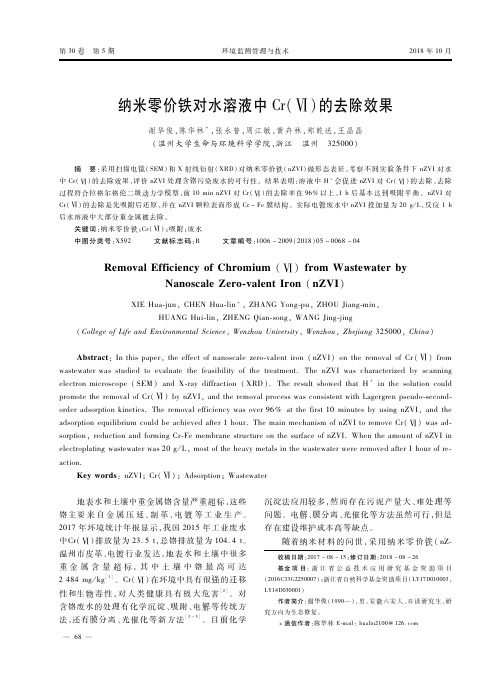
第 #' 卷%第 & 期
谢华俊等$纳米零价铁对水溶液中 =L" 1$ 的去除效果
"'!+ 年 !' 月
e0$ 修 复 重 金 属 污 染 水 体 已 经 成 为 研 究 的 热 点& 59e0具有粒径 小! 比 表 面 积 大! 活 性 高 等 特 点! 对 水体 中 铬 的 去 除 机 理 主 要 是 吸 附( 还 原 和 共 沉 淀 )) -X* !=L" 1 $ 被 吸 附 后! 与 59e0颗 粒 表 面 的 YC__>形成" =LCYC! -C$ " _>$ # 或 =LCYC! -C__> 膜 结构 )+* & =L" 1$ 也 会 被 溶 液 中 YC" g或 者 59e0腐 蚀产生的活性氢 原 子 还 原!生 成 YC" # $ -=L" # $ 络合物!发生共 沉 降 ).* & 今 通 过 探 讨 59e0对 铬 的 吸附 降 解 机 理! 以 及 在 不 同 条 件 下 对 水 溶 液 中 =L" 1$ 的去除效果!评 价 59e0处 理 含 铬 污 染 废 水 的可行性& 该研究结果对 59e0在含铬污染废水处 理中的应用具有一定意义&
6=.+"(*+% 05 O:2DKAKCL! O:CCPPC;OBP5A5BD;ARC`CLB3TARC5O2LB5 " 59e0$ B5 O:CLCSBTARBP=L" 1 $ PLBS QADOCQAOCLQADDO<N2CN OBCTAR<AOCO:CPCAD2U2R2O4BPO:COLCAOSC5O$J:C59e0QAD;:ALA;OCL2`CN U4D;A55256 CRC;OLB5 S2;LBD;BKC" V?^$ A5N *3LA4N2PPLA;O2B5 " *dH$ $J:CLCD<ROD:BQCN O:AO>g 25 O:CDBR<O2B5 ;B<RN KLBSBOCO:CLCSBTARBP=L" 1$ U459e0! A5N O:CLCSBTARKLB;CDDQAD;B5D2DOC5OQ2O: /A6CL6LC5 KDC<NB3DC;B5N3 BLNCLANDBLKO2B5 Z25CO2;D$J:CLCSBTARCPP2;2C5;4QADBTCL.)[ AOO:CP2LDO!' S25<OCDU4<D25659e0! A5N O:C ANDBLKO2B5 Ca<2R2UL2<S ;B<RN UCA;:2CTCN APOCL! :B<L$J:CSA25 SC;:A52DS BP59e0OBLCSBTC=L" 1$ QADAN3 DBLKO2B5! LCN<;O2B5 A5N PBLS256=L3YCSCSULA5CDOL<;O<LCB5 O:CD<LPA;CBP59e0$W:C5 O:CASB<5OBP59e025 CRC;OLBKRAO256QADOCQAOCLQAD"' 6b/! SBDOBPO:C:CAT4SCOARD25 O:CQADOCQAOCLQCLCLCSBTCN APOCL! :B<LBPLC3 A;O2B5$
纳米零价铁去除水中污染物的研究进展

第 2 期 代 莹 ,等 :纳米零价铁去除水中污染物的研究进展
· 47 ·
盐 、卤代烃等多种污染物 ,并且可以大大减少毒性 副产物的生成 。 不仅如此 ,nZVI 颗粒还可以直接 被注入到被污染的蓄水层中 ,对污染的蓄水层进行 原位修复 ,为地下水中污染物的原位修复寻求到了 一条新颖而特效的途径 。
(1 .College of Civil and Architectural Engineering ,Heilongjiang Institute of Technology ,Harbin 150050 ,China ;2 .School of Chemistry and M aterials Science ,Heilongjiang U niversity ,Harbin 150080 ,China)
Research of nano zero valent iron for the removal of pollutants from water
DAI Ying1 ,2 ,ZO U Jin‐long2 ,WA NG Wei1 ,Z H A NG Xin1 ,LIANG T ao1 ,Z H A NG M in1
重金属污染物包括 汞 、铅 、铜 、铬 、镍 、铁 、锰 、 等[5] ,重金属在水环境中不会降解 、消失 ,而是通过 迁移 、转化等途径在各圈层之间转换 ,一旦通过产 品的富集由食物链进入人体 ,会对人类健康构成极 大的危害 。 纳米零价铁对水中重金属离子去除的 作用主要有还原 、吸附和共沉淀作用 。 重金属离子 不同 ,其去除机理也不同 ,还有可能是多种机理共 同作用 ,比如既存在吸附作用也存在还原作用 ,或 者吸附中伴有沉淀的作用 ,各种机理共同作用使得 溶液中的重金属离子得以高效去除 ,并且避免了二 次污染的问题 。 3畅 1畅 1 表面吸附 — 配合
镍铁双金属系列电催化材料的研究进展

镍铁双金属系列电催化材料的研究进展王雅;方志强;史晓雨;楚意月;郝召民【摘要】氢能源由于其成本低、可再生、绿色环保等优点,成为世界上公认的清洁能源之一.电解水则是目前最有潜力的提供氢燃料的方案之一,镍铁双金属电催化剂由于其来源丰富、成本低、清洁无污染且有较强的催化性能,得到了人们的广泛关注.本文主要综述了近些年来双金属镍铁氧化物和镍铁合金方面的发展与研究,对他们的合成方法,性能及其稳定性进行了深入探讨.【期刊名称】《化学研究》【年(卷),期】2018(029)006【总页数】4页(P638-641)【关键词】电化学;双金属镍铁电催化剂;析氢反应;析氧反应【作者】王雅;方志强;史晓雨;楚意月;郝召民【作者单位】河南大学化学化工学院,河南开封475004;河南大学化学化工学院,河南开封475004;河南大学化学化工学院,河南开封475004;河南大学化学化工学院,河南开封475004;河南大学化学化工学院,河南开封475004【正文语种】中文【中图分类】O613.72随着化石燃料的逐渐枯竭及其相关的负面环境影响,合理开发可再生资源是解决当前能源,实现能源结构调整并保证人类社会经济和环境可持续发展的重要条件,同时也是当前社会的迫切需要[1-2]. 纵观各种可替代的能源,氢能源是洁净的低碳、可再生资源,不但能量密度高,其燃烧的产物水几乎对环境没有影响[3]. 目前世界上大部分的氢气是以化石燃料为原料进行制取的,不仅消耗了大量的化石能源,而且对环境产生有害的气体. 电化学水分解则是公认的一个最有潜力的解决方案之一为未来全球环境污染和能源危机提供可再生清洁的氢燃料[4-5]. 电解水反应一般分为两类:析氢反应(HER)和析氧反应(OER)[6]. 两者的分离效率对整体水分解都非常重要. 因此,为了降低过电势,加快反应速率,提高能量转换效率,需要一个高效的催化剂去降低反应能量势垒. 已经尝试很多方法去提高对于电水解反应的效率,包括在酸性和碱性条件中,之后发现贵金属铂、钯、钌、铑催化剂在HER和OER 中能表现出高效电催化性能,降低反应所需电压. 但高成本,低资源限制了他们在析氢反应和析氧反应中的广泛应用. 所以当前在清洁能源领域一个主要的目标是去发现高效,廉价的非贵金属催化剂把水分解成氢.为了更有效地解决这个问题,许多科研人员把研究集中在双金属镍铁的电催化剂上. 镍铁在自然界中资源丰富且价格低廉,且人们研究发现双金属镍铁电催化剂具有良好的催化活性,低的过电势和优秀的稳定性,有利于电催化水的大规模产业化,符合国家一直提倡的发展绿色环保新能源的要求[7]. 本文主要综述了镍铁电催化剂近些年的研究进展,对他们的合成、结构以及电催化性能进行了分析和讨论,并对这些催化电极材料的性能进行总结与展望.1 镍铁合金对能量储存和应用的迫切需要,急需我们发展高效率,低成本的多功能电催化剂应用于电化学分解水. 由于NiFe合金催化活性高,稳定性好,电势低等优点,近些年来在电催化方面得到了突飞猛进的发展. 例如:在2017年XU等[8]报道了由直接镍基化修饰的镍/铁金属有机骨架衍生而成的NiFe-Se/c纳米棒作为高效率非贵金属电催化剂. 1 mol/L的KOH溶液中,在电流密度10 mA·cm-2析氢反应电压仅仅为160 mV、析氧反应为240 mV,且都表现出很高的催化活性. 同时,优化的NiFe-Se/c纳米棒的塔菲尔斜率为73 mV·dec-1,显著低于RuO2 (94 mV·dec-1), Ni/Fe@C(105 mV·dec-1) 和裸泡沫镍的(109 mV·dec-1)(如图1). 在这项研究中,虽然电压有所降低,但并没有达到我们理想中的电压值. 之后HAKHYEON等[9]在2017年,利用镍铁反纳米结构发现了高效率,低成本的镍铁双功能电催化剂应用于水分解反应,通过优化反纳米结构的厚度层,在1 mol/L 的NaOH中电流为10 mA·cm-2时镍铁(IO)能够降低OER和HER的电压分别到70、90 mV. 由于镍铁纳米材料催化性能的增强主要是依赖于多的活性位点和大的比表面积,反应物和产物主要在纳米多孔IO表面参与反应,有效减小了电子在高电位下的迁移率. 另外,2018年LIU等在工作中[10],通过一个简单的途径合成了一类FeNi@N-GR纳米复合材料的多功能电催化剂.图1a显示了FeNi@N-GR催化剂的OER的极化曲线. 证明FeNi@N-GR核壳纳米结构在析氢反应和析氧反应中具有高活性和稳定性双功能催化,为设计电化学和其他可利用能源的多功能催化剂提供了一个新的途径.图1 LIU课题组测试的(a)OER极化曲线和(b)NiFeSe /C纳米棒、Ni/Fe OH、Ni/Fe @ C、IrO2和裸Ni泡沫在1 mol/L KOH中的对应塔菲尔图. (c)NiFeSe / C纳米棒在不同扫描速率下的极化曲线. (d)NiFeSe / C纳米棒在静态过电位为240 mV下的时间依赖电流密度曲线20 hFig.1 (a) OER polarization curves and (b) Corresponding Tafel plots of NiFe-Se/C nanorods, Ni/Fe-OH, Ni/Fe@C, IrO2 and bare Ni foam in 1.0 mol/L KOH. (c) LSV plots for the NiFeSe/C nanorods at different scan rates. (d) Time-dependent current density curve for the NiFeSe/C nanorods under a static overpotential of 240 mV for 20 h tested by the LIU’s group2 NiFeOx及其复合物由于Ni、Fe及其NiFe氧化物在自然界中拥有丰富的自然资源并且他们也是自然界中重要的半导体材料,近些年来被广泛地应用在很多领域. 另外他们具有价格低廉,催化活性高以及稳定性好等优点,被广泛用作电解水的电催化剂. 在电学、光学、以及磁学中,对材料的尺寸、大小以及一些微观结构都有比较严格的要求. 因此,很多课题研究致力于对镍铁氧化物的微观结构的研究. 例如:2018年我们课题组[11]在NiFe-MOF中密闭渗碳并进行二次煅烧,成功地合成了双金属NiFe2O4(如图2),并通过XRD、XPS、SEM和TEM进行表征,合成的NiFe2O4化合物在碱性条件下展现了很好的催化性能与很高的稳定性. 从中我们可以得到启发,合成的NiFe2O4化合物将提高MOFs在非贵金属作为OER电催化剂中的应用.图2 HAO课题组合成的NiFe MOFs两步热处理制备NiFe2O4材料的示意图Fig.2 Schematic representation of the formation of NiFe2O4 materials through the two-step thermal treatment of NiFe-MOFs in HAO’s group 除了我们课题组做了研究外,其他研究工作者也做了大量的工作. 在2018年,KUMAR等[12]发现由镍铬青铜模拟金属-有机骨架制成的介孔氧化镍纳米立方体(NiFe-NCs),可以作为一种有效的用于全解水的催化剂. 在该电催化材料中,具有200 nm侧边长度的NiFe-NCs中 Ni/Fe物质的量之比为3∶2,是NiO和α/γ-Fe2O3的复合物. NiFe-NCs在1 mol/L KOH溶液中,10 mA·cm-2的过电势处演示OER和HER的过电势是271、197 mV,优于具有类似组成的球形镍铁氧化物纳米粒,而当全解水时,在电流密度为10 mA·cm-2使用NiFe-NCs时只需1.67 V的电压. NiFe-NCs水分解催化剂表现出长期稳定的耐腐蚀性能,同时NiFe-NCs暴露的边缘和顶点处的活性位点对它们的整体催化性能起着至关重要的作用. 此外DENG等在2017年发现[13],具有离散N掺杂石墨碳覆盖层的核壳NiFe纳米复合物可以用于增强水氧化,促进析氧反应. 被离散N掺杂石墨覆盖层的核/壳NiFe纳米复合物在析氧反应活性和稳定性方面增强,并具有低起始电位1.48 V,降低过电位320 mV·cm-1,小的塔菲尔斜率值41 mV·dec-1,优于Ir/C. 除此之外,2015年FOMINYKH等对铁掺杂氧化镍纳米晶在碱性条件下水分解的高效电催化剂作了相关研究[14]. 通过XRD和EDS测定了纳米颗粒的铁含量和组成(如图3),结构分析显示Fe3+已进入NiO岩盐结构. 纳米颗粒在乙醇中的优异分散性使其可以在各种衬底上制备具有光滑表面的大约8 nm的均匀薄膜.Fe0.1Ni0.9O在电压为300 mV时具有高效电化学催化水分解性能,而且在电流为10 mA·cm-2时电压仅为297 mV,塔菲尔斜率为37 mV·dec-1. 其次通过溶剂热合成的超小、可结晶的NiO纳米粒(NPS),发现其性能不太理想,当NiO纳米粒中加入20%铁时,发现其性能明显增强. 当纳米粒在电压为300 mV时展现的最高周转频率是1.9 s-1,对于百分之十的三价铁杂质,优于大量的铁镍氧化物和昂贵的稀土铱催化剂. Fe0.1Ni0.9O组成中粒子尺寸的降低和高结晶率使其长时间电解之后仍能稳定存在,有利于大幅度提高电催化活性和结构的稳定性.(a)概述纳米颗粒分散在TEM网格上. (b)单一的Fe0.1Ni0.9O纳米粒子的HRTEM 图像. (c)几十个Fe0.1Ni0.9O的电子衍射图样纳米颗粒.图3 KSENIA FOMINYKH 课题组测试的Fe0.1Ni0.9O纳米粒子(NP-10%)的TEM图像Fig.3 TEM images of the Fe0.1Ni0.9O nanoparticles (NP-10%)3 总结与展望由于镍铁在地球上拥有丰富的资源,且成本低易于获取,发展镍铁电催化剂在析氢反应和析氧反应方面具有巨大的应用价值. 尤其是镍铁合金、镍铁氧化物和镍铁双层金属氧化物近些年的发展,使得镍铁双金属电催化在低电压、低成本、低消耗、环境友好方面得到了很大进步,促进了电催化的进一步发展. 电催化剂从与贵金属性能的研究到与非贵金属的性能的发展,是研究过程中的重要突破,为电催化剂提供了更为广阔的发展空间.参考文献:【相关文献】[1] WANG C, WANG X, ZHANG X, et al. Hierarchically porous Ni3S2 nanorod array foam as highly efficient electrocatalyst for hydrogen evolution reaction and oxygen evolution reaction [J]. Electrochimica Acta, 2015, 174(18): 297-301.[2] SUN X P, TIAN J Q, ABDULLAH M A, et al. Self-supported nanoporous cobalt phosphide nanowire arrays: an efficient 3D hydrogen-evolving cathode over the wide range of pH 0-14 [J]. Journal of America Chemietry Society, 2016, 72(21): 7587-7590. [3] MORALES-GUIO G G, STERM L A, HU X. Nanostructured hydrotreating catalysts for electrochemical hydrogen evolution [J]. Chemical Society Reviews, 2014, 43(18): 6555-6560.[4] ZOU X, ZHANG Y. Noble metal-free hydrogen evolution catalysts for water splitting [J]. Chemical Society Reviews, 2015, 44(15): 5148-5180.[5] COOK T R, DOGUTAN D K, REECE S Y, et al. Solar energy supply and storage for the legacy and nonlegacy worlds [J]. Chemical Reviews, 2010, 110(11): 6474-6502.[6] VESBORG P C, SEGER B, CHORKENDORFF I. Recent development in hydrogen evolution reaction catalysts and their practical implementation [J]. Journal of Physical Chemistry Letters, 2015, 6(6): 951-956.[7] GONG M, ZHOU W, TSAI M C, et al. Nanoscale nickel oxide/nickel heterostructures for active hydrogen evolution electrocatalysis [J]. Nature Communications, 2014, 5(15): 4695-4701.[8] XU B, YANG H, YUAN LC, et al. Direct selenylation of mixed Ni/Fe metal-organic frameworks to NiFe-Se/C nanorods for overall water splitting [J]. Journal of Power Sources, 2017, 366(17): 193-199.[9] SONG H, OH S, YOON H, et al. Bifunctional NiFe inverse opal electrocatalysts with heterojunction Si solarcells for 9.54%-efficient unassisted solar water splitting [J]. Nano Energy, 2017, 429(21): 1-7.[10] LIU P T, GAO D Q, XIAO W, et al. Self-powered water-splitting devices by core-shell NiFe@N-graphite-based Zn-Air batteries [J]. Advanced Functional Mater, 2018, 28(14): 1706928-1706936.[11] FANG Z Q, HAO Z M, DONG Q S, et al. Bimetallic NiFe2O4 synthesized via confined carburization in NiFe-MOFs for efficient oxygen evolution reaction [J]. Journal ofNanoparticle Research, 2018, 20(14): 106-115.[12] KUMAR A, BHATTACHARRYA S. Porous NiFe-Oxide nanocubes as bifunctional electrocatalysts for efficient water-splitting [J]. ACS Applied Materials Interfaces, 2017, 9(48): 41906-41915.[13] DENG C, WU KH, SCOTT J, et al. Core/shell NiFe nanoalloy with a discrete N-doped graphitic carbon cover for enhanced water oxidation [J]. ChemElectroChem, 2018, 5(5): 732-736.[14] FOMINYKH K, CHERNEV P, ZAHARIEVA I, et al. Iron-doped nickel oxide nanocrystalsas highly efficient electrocatalysts for alkaline water splitting [J]. ACS Nano, 2015, 9(6): 5180-5188.。
果胶稳定的纳米零价铁去除水中Cr(Ⅵ)的研究

果胶稳定的纳米零价铁去除水中Cr(Ⅵ)的研究张悦;苏冰琴;张弛;姜玉俊【摘要】以果胶为稳定剂,制备果胶稳定的纳米级零价铁材料,进行试验,以期得到最佳反应条件,并进行动力学研究。
结果表明,当果胶投加量为0.6 g/L,果胶-nZVI投加量为0.12 g/L,pH条件为5.5,环境温度为25℃时,反应60 min后Cr(Ⅵ)的去除率可达98.3%,反应可用伪一级反应动力学模型来描述。
通过ln(C/C0)对t作图进行曲线拟合,可以得到表观速率常数kobs=0.0132 min-1和相关系数R2=0.8351,证明ln(C/C0)与t呈较为良好的线性关系。
%Using pectin as its stabilizer,the pectin-stabilized nanoscale zero-valent iron material has been prepared, and a batch of tests have been conducted,so as to obtain the optimum reaction conditions and carry out the kinetics research. The results show that when the dosage of pectin is 0.6 g/L,the pectin-nZVI dosage 0.12 g/L,pH 5.5,and environment temperature 25℃,the removing rate of Cr (Ⅵ) can reach 98.3%after reacted for 60 min. The pseudo-first-order reaction kinetics model can be used for describing this reaction. The apparent speed rate constant (kobs=0.013 2 min-1) and correlation coefficient(R2=0.835 1) can be obtained by making a curve fitting between ln(C/C0) and reaction time,indicating that ln(C/C0) and reaction time have a good linear relationship.【期刊名称】《工业水处理》【年(卷),期】2016(000)009【总页数】4页(P47-50)【关键词】纳米零价铁;果胶;稳定剂;Cr(Ⅵ);动力学模型【作者】张悦;苏冰琴;张弛;姜玉俊【作者单位】太原理工大学环境科学与工程学院,山西晋中030600;太原理工大学环境科学与工程学院,山西晋中030600;太原理工大学环境科学与工程学院,山西晋中030600;太原理工大学环境科学与工程学院,山西晋中030600【正文语种】中文【中图分类】X703.1随着科技进步,在人类寻求工业科技快速发展的同时,越来越多的铬污染问题也相继产生。
金属有机框架材料对水体中重金属离子去除性能及机理的研究进展
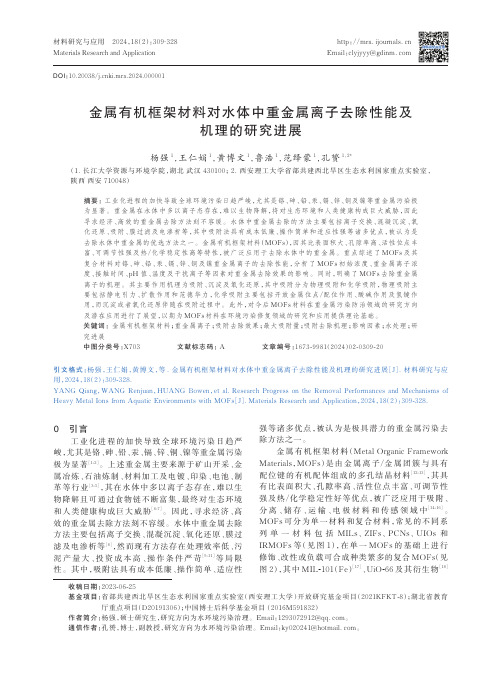
材料研究与应用 2024,18(2):309‐328Materials Research and ApplicationEmail :clyjyyy@http ://mra.ijournals.cn 金属有机框架材料对水体中重金属离子去除性能及机理的研究进展杨强1,王仁娟1,黄博文1,鲁浩1,范绎蒙1,孔赟1,2*(1.长江大学资源与环境学院,湖北 武汉 430100; 2.西安理工大学省部共建西北旱区生态水利国家重点实验室,陕西 西安 710048)摘要: 工业化进程的加快导致全球环境污染日趋严峻,尤其是铬、砷、铅、汞、镉、锌、铜及镍等重金属污染极为显著。
重金属在水体中多以离子态存在,难以生物降解,将对生态环境和人类健康构成巨大威胁,因此寻求经济、高效的重金属去除方法刻不容缓。
水体中重金属去除的方法主要包括离子交换、混凝沉淀、氧化还原、吸附、膜过滤及电渗析等,其中吸附法具有成本低廉、操作简单和适应性强等诸多优点,被认为是去除水体中重金属的优选方法之一。
金属有机框架材料(MOFs ),因其比表面积大、孔隙率高、活性位点丰富、可调节性强及热/化学稳定性高等特性,被广泛应用于去除水体中的重金属。
重点综述了MOFs 及其复合材料对铬、砷、铅、汞、镉、锌、铜及镍重金属离子的去除性能,分析了MOFs 初始浓度、重金属离子浓度、接触时间、pH 值、温度及干扰离子等因素对重金属去除效果的影响。
同时,明确了MOFs 去除重金属离子的机理。
其主要作用机理为吸附、沉淀及氧化还原,其中吸附分为物理吸附和化学吸附,物理吸附主要包括静电引力、扩散作用和范德华力,化学吸附主要包括开放金属位点/配位作用、酸碱作用及氢键作用,而沉淀或者氧化还原伴随在吸附过程中。
此外,对今后MOFs 材料在重金属污染防治领域的研究方向及潜在应用进行了展望,以期为MOFs 材料在环境污染修复领域的研究和应用提供理论基础。
关键词: 金属有机框架材料;重金属离子;吸附去除效果;最大吸附量;吸附去除机理;影响因素;水处理;研究进展中图分类号:X703 文献标志码: A 文章编号:1673-9981(2024)02-0309-20引文格式:杨强,王仁娟,黄博文,等.金属有机框架材料对水体中重金属离子去除性能及机理的研究进展[J ].材料研究与应用,2024,18(2):309-328.YANG Qiang ,WANG Renjuan ,HUANG Bowen ,et al.Research Progress on the Removal Performances and Mechanisms of Heavy Metal Ions from Aquatic Environments with MOFs [J ].Materials Research and Application ,2024,18(2):309-328.0 引言工业化进程的加快导致全球环境污染日趋严峻,尤其是铬、砷、铅、汞、镉、锌、铜、镍等重金属污染极为显著[1-2]。
采用负载Ni0.5Zn0.5Fe2O4磁性纳米粒子芦荟壳灰从水溶液中快速高效去除Ag(I)

Trans.Nonferrous Met.Soc.China26(2016)2238−2246Fast and efficient removal of silver(I)from aqueous solutions using aloe vera shell ash supported Ni0.5Zn0.5Fe2O4magnetic nanoparticlesParisa BEIGZADEH,Farid MOEINPOURDepartment of Chemistry,Bandar Abbas Branch,Islamic Azad University,Bandar Abbas7915893144,IranReceived16August2015;accepted4March2016Abstract:Silver(I)was removed from aqueous environment by aloe vera shell ash supported Ni0.5Zn0.5Fe2O4magnetic nanoparticles. The adsorbent was characterized by several methods including X-ray diffraction(XRD),scanning electron microscopy(SEM),BET isotherm,vibrating sample magnetometer(VSM)and Fourier transform infrared spectroscopy(FT-IR).To determine the absorption of silver(I)by this adsorbent,different pH values(2−7),adsorbent dose(0.01−0.5g),concentrations of Ag+(50,100,200,300,500, 700and1000mg/L)and exposure time(5−100min)were experimented.The highest removal efficiency of Ag+was achieved under optimum condition(30min and pH=5).The optimum adsorbent dose was0.20g(in50mL of100mg/L Ag+solution),which achieved a removal efficiency of98.3%.The maximum monolayer adsorption capacity based on the Langmuir isotherm is 243.90mg/g.Characterization results revealed that specific surface area and porous volume were814.23m2/g and0.726cm3/g, respectively.The experimental data were fitted well with the Langmuir and Freundlich isotherm models.Synthesized adsorbent has desired surface area and adsorptive capacity for silver(I)adsorption in aquatic environment.Key words:adsorption;Ag+ions;Ni0.5Zn0.5Fe2O4;aloe vera1IntroductionHeavy metals as raw materials or catalysts are used extensively in many industrial processes,such as mining, metallurgy,electrolysis,electroplating and leather[1]. They can be afterward discharged into the environment via wastewater,which has become a hazard to human and local environment[2].Because the heavy metals in water are difficult to be bio-degenerated and tend to cumulate in living structures through the food chain[3], the wastewater including heavy metals should be cleaned up before evacuation.Wastewater comprising heavy metals is usually cleaned up via precipitation,membrane separation,ion exchange,and adsorption[4−7].Among them,adsorption was established as an important and economically practical treatment technology for removing the Ag+ions from water and wastewater. Activated carbon is usually used adsorbent for the removal of Ag+ions from aqueous solution.Despite the abundance applications of activated carbon,its use is sometimes limited due to its high cost and also for loss during its re-formation[8−10].Therefore,the researchers are on the search for new low-cost substitute adsorbents for the water pollution control,especially,where cost acts an important role.Much effort has been done towards the development of another adsorbents that are effective and low-cost.They can be produced from a wide diversity of raw materials,which are abundant and have high carbon and low inorganic content.Owing to the low cost and high accessibility of these materials,it is not essential to have complex regeneration processes. Such low cost adsorption methods have attracted many researchers.Often,the adsorption capabilities of such adsorbents are not large,therefore,the study and investigation of more and more new adsorbents are still under development.Several common adsorbents of different origin,primarily including activated carbons, clays,zeolites,biomass,and polymeric materials,have been used for the removal of heavy metal from the industrial wastewater[11−15].In recent years,due to economic problems,creating a cheap and efficient alternative method of wastewater treatment instead of expensive and inefficient methods is of great importance.One of the most efficient,technical and economic methods in this context,is the use of magnetic adsorbent.These adsorbents have magnetic properties and by using an external magnetic field they can beCorresponding author:Farid Moeinpour;Tel/Fax:+98-761-6670242;E-mail:f.moeinpour@;fmoeinpour52@iauba.ac.ir DOI:10.1016/S1003-6326(16)64341-8Parisa BEIGZADEH,et al/Trans.Nonferrous Met.Soc.China26(2016)2238−22462239easily separated from the solution.In the magnetic separation,high costs of separation,such as centrifugation and filtration are not included[16]. Extensive researches in the field of magnetization of materials such as chitosan[17],silica[18],polymer[19] and activated carbon[20]have been conducted for water contaminants removal.The use of this property in the nanoparticles,due to their high specific surface area and adsorption capacity is very good[21−23].Nickel−zinc ferrites have drawn noticeable consideration of researchers as a result of their remarkable magnetic properties,large permeability,and very high electrical resistivity[24].They have extensive potential applications such as high–density information storage devices,microwave devices,transformer cores,and magnetic fluids[25].The use of activated carbon to remove chlorine,separating gases and air pollution treatment,recycling of heavy metals from aqueous solutions has many applications.But because of the high cost,other options have been suggested as an alternative. Ash due to the low cost of production is a good alternative to activated carbon[26−30].Ashes can be produced from a wide range of carbon materials,such as wood,coal,shell,walnut shell,fruit stones,and agricultural waste[31].In this work,we became interested to investigate the capability of the surface modified Ni0.5Zn0.5Fe2O4 magnetic nanoparticles with ash prepared from aloe vera shell(Ni0.5Zn0.5Fe2O4/ASA)as a low-cost adsorbent for removal of Ag+ions from aqueous solution and also to study the adsorption mechanism of Ag+ions onto this adsorbent.For this purpose,a set of batch adsorption experiments(pH,contact time,adsorbent dosage and initial Ag+ions concentration)on the Ag+ions removal using this adsorbent were carried out at optimum conditions.The characterization of the adsorbent was described by FT-IR,XRD and SEM analyses.2Experimental2.1Materials and methodsAnalytical-grade salt AgNO3was obtained from Merck.A1000mg/L stock solution of the salt was prepared in deionized water.All working solutions were prepared by diluting the stock solution with deionized water.Deionized water was prepared using a Millipore Milli-Q(Bedford,MA)water purification system. All reagents(Fe(NO3)3·9H2O,Zn(NO3)2·6H2O and Ni(NO3)2·6H2O,NaOH and HNO3)used in the study were of analytical grade and purchased from Aldrich. Before each experiment,all glassware were cleaned with dilute nitric acid and repeatedly washed with deionized water.X-ray diffraction analysis(XRD)was carried out using a PAN analytical X’Pert Pro X-ray diffractometer.Surface morphology and particle size were studied using a Hitachi S−4800SEM instrument.FT-IR spectra were determined as KBr pellets on a Bruker model470 spectrophotometer.The specific surface(S BET)of Ni0.5Zn0.5Fe2O4/ASA was determined by a micrometrics apparatus(Gemini2375)by adsorption of nitrogen at77 K according to the traditional method of Brunauer Emmet and Teller or BET.All the metal ion concentrations were measured with a Varian AA240FS atomic absorption spectrophotometer.2.2Synthesis of aloe vera shell ash(ASA)Aloe vera is grown in southern Iran.Aloe vera shells were collected from,Qeshm Island,Hormozgan, Iran,and were applied as a raw material for the preparation of surface modified adsorbent.The collected aloe vera shells were washed and dried in an air oven at 80°C for24h and then ground and sieved to the desired particle size(2–3mm).The resultant sieved powder was carbonized in a furnace at700°C at heating rate of 10°C/min for2h.The methods for producing carbon materials are similar to other studies also have been used[26].2.3Synthesis of Ni0.5Zn0.5Fe2O4/ASAAt first,Ni−Zn ferrite was prepared using stoichiometric ratios of metal nitrates to freshly extracted egg-white[32].The metal nitrates(Fe(NO3)3·9H2O, Zn(NO3)2·6H2O and Ni(NO3)2·6H2O)and2g ASA were dissolved together in a minimum amount of double distilled water to get a clear solution.60mL of extracted egg-white dissolved in40mL of double distilled water while vigorous stirring,was added to nitrate mixture at ambient temperature.After constant stirring for30min, the resultant sol−gel was evaporated at80°C until dry precursor was obtained.The dried precursors were ground and calcined in a muffle furnace at550°C for 2h.2.4Adsorption experimentsBatch adsorption of silver ions onto the adsorbent (Ni0.5Zn0.5Fe2O4/ASA)was investigated in aqueous solutions under various operating conditions viz pH2−7, at a temperature of298K,for an initial Ag+ion concentration of100mg/L.About0.20g adsorbent was added to50mL of silver nitrate solution(100mg/L). Then,the mixture was agitated on a shaker at250r/min. The initial pH values of the silver solutions were adjusted from2to7with0.1mol/L HNO3or0.1mol/L NaOH solutions using a pH meter.After equilibrium,the samples were centrifuged and the adsorbent (Ni0.5Zn0.5Fe2O4/ASA)was removed magnetically from the solution.The Ag+concentration and final pH in theParisa BEIGZADEH,et al/Trans.Nonferrous Met.Soc.China 26(2016)2238−22462240supernatant were measured by flame atomic absorption spectrometer and a pH meter,respectively.The effects of several parameters,such as contact time,initial concentration,pH and adsorbent dose on extent of adsorption of Ag +were investigated.Each datum point was taken as the average of three measurements.The Ag +removal rate (R )was calculated as0t100%c c c η-=⨯(1)where c 0and c t (mg/L)are the concentrations of Ag +in the solution at initial and equilibrium time,respectively.The amount of Ag +adsorbed (Q e )was calculated using mVc c Q )(e 0e -=(2)where c e is the equilibrium concentration of Ag +(mg/L),m is the mass of adsorbent (g),and V is the volume of solution (L).To specify the regeneration of the adsorbent (Ni 0.5Zn 0.5Fe 2O 4/ASA)sample,adsorption/desorption cycles were repeated 5times using the same adsorbent sample.Na 4−EDTA (0.1mol/L)was used as a desorption agent.Adsorbent (Ni 0.5Zn 0.5Fe 2O 4/ASA)samples carrying 99.95mg/g Ag +were placed in this desorption medium (25mL)and stirred magnetically at 25°C for 1h.After 1h,the aqueous phase was separated from the adsorbent and the concentration of Ag +in that phase was measured.2.5Adsorption isothermsAdsorption isotherms were obtained by using 0.20g of adsorbent and 50mL of silver nitrate solution with different concentrations (50−1000mg/L)at 298K.These solutions were buffered at an optimum pH (pH=5)for adsorption and agitated on a shaker at 250r/min until they reached adsorption equilibrium (30min).The quantity of Ag +adsorbed was derived from the concentration change.3Results and discussion3.1Characterization of Ni 0.5Zn 0.5Fe 2O 4/ASA magnetic nanoparticles Ni 0.5Zn 0.5Fe 2O 4nano-crystallites were prepared according to the reported procedure by GABAL et al [32].Ni 0.5Zn 0.5Fe 2O 4/ASA nanocrystallites were characterized by FT-IR (Fig.1),XRD (Fig.2)and SEM (Fig.3).FT-IR spectra of Ni 0.5Zn 0.5Fe 2O 4,Ni 0.5Zn 0.5-Fe 2O 4/ASA and ASA are compared in Fig.1.In the FT-IR spectrum of Ni 0.5Zn 0.5Fe 2O 4/ASA (Fig.1(a)),most of the bands of Ni 0.5Zn 0.5Fe 2O 4(Fig.1(c))and ASA (Fig.1(b))with a slight shift for some of them,areFig.1FTIR spectra of Ni 0.5Zn 0.5Fe 2O 4/ASA (a),ASA (b),and Ni 0.5Zn 0.5Fe 2O 4(c)Fig.2XRD patterns of Ni 0.5Zn 0.5Fe 2O 4:(a)Synthesized Ni 0.5Zn 0.5Fe 2O 4;(b)Standard Ni 0.5Zn 0.5Fe 2O 4(JCPDS 08−0234)Fig.3SEM image of Ni 0.5Zn 0.5Fe 2O 4/ASA nanocompositeobservable,which shows that ASA has been supported well on the Ni 0.5Zn 0.5Fe 2O 4.The bands are in the low-frequency region (1000−500cm −1)due to iron oxide skeleton,which is in agreement with the magnetite spectrum.The peak at 1444.85cm −1showed the existence of Fe —O [33].In Fig.1(a),the presence of —OH stretching mode is evident by the peak close toParisa BEIGZADEH,et al/Trans.Nonferrous Met.Soc.China26(2016)2238−22462241 3446.75cm−1.To confirm the Ni ferrite formation in thesynthesized magnetic nanoparticles,the XRD spectrumof the sample was studied.The XRD patterns(Fig.2)show that Ni0.5Zn0.5Fe2O4nanoparticles have the spinelstructure,with all the major peaks matching the standardpattern of bulk Ni0.5Zn0.5Fe2O4(JCPDS08−0234).Theparticle size of adsorbent was investigated by SEM.TheSEM photograph of sample(Fig.3)shows that averagesize of Ni0.5Zn0.5Fe2O4/ASA is approximately less than100nm.The magnetic properties of the Ni0.5Zn0.5Fe2O4/ASAwere evaluated by a vibrating sample magnetometer(VSM).As shown in Fig.4,the saturation magneticmoments of the Ni0.5Zn0.5Fe2O4/ASA reached about17kA/m.It showed superparamagnetic behavior thatwould enable easy recovery of the adsorbent fromsolution under an applied magneticfield.Fig.4VSM curve of Ni0.5Zn0.5Fe2O4/ANSA at roomtemperatureSome properties of the Ni0.5Zn0.5Fe2O4/ASA arepresented in Table1.The Ni0.5Zn0.5Fe2O4/ASA has asurface area about814.23m2/g and a porous volumeequal to0.726cm3/g.Table1Properties of Ni0.5Zn0.5Fe2O4/ASASpecific surface area/(m2·g−1)Porousvolume/(cm3·g−1)Water content/%814.230.726Trace3.1Adsorption and removal of Ag+from aqueoussolution3.1.1Effect of contact timeThe effect of contact time on the amount of silver adsorbed was studied at100mg/L initial concentration of silver.It could be observed from Fig.5that with the increase of contact time,the adsorption also increased. Minimum adsorption was90.0%for5min and maximum adsorption value was97.0%for30min.The adsorption characteristic indicated a rapid uptake of the silver.The adsorption rate,however,reduced to a constant value with an increase in contact time because all available sites were covered,and no active site was present foradsorbing.Fig.5Effect of contact time on removal efficiency(initial concentration=100mg/L,pH=7,adsorbent dose=4g/L and T= 298K)3.1.2Effect of pHThe acidity of the aqueous solution applies a considerable effect on the adsorption process because it can affect the solution chemistry of contaminants and the state of functional groups on the surface of adsorbents [34−36].The effect of solution pH on Ag+adsorption was studied at pH2−7at298K.As shown in Fig.6,the adsorption rate of Ag+is enhanced with increasing pH from2to7.However,at low pH values,hydrogen ions (H+)are likely to compete with Ag+and thus lower the amount of Ag+removed.Therefore,the great Ag+ adsorption occurring at higher pH could be described to a decrease in competition between H+and Ag+at the same adsorption site of the adsorbent beads.At pH>6,theFig.6Effect of pH on Ag+removal at different pH values (initial Ag+concentration=100mg/L,adsorbent dose=4g/L contact time=30min and T=298K)Parisa BEIGZADEH,et al/Trans.Nonferrous Met.Soc.China26(2016)2238−2246 2242Ag+ions begin to hydrolyze and then form insoluble silver hydroxide.At this time,both adsorption and precipitation are effective mechanisms in the removal of Ag+ions from aqueous solution[37].Therefore,the maximum adsorption occurs at around pH5.0and it is therefore selected for all adsorption experiments in this study.In order to check the stability of Ni0.5Zn0.5Fe2O4/ ASA in acidic medium,the reaction mixture in pH5 (optimized pH)was subjected to the elemental analysis by ICP-AEM technology and no Ni,Zn and Fe were detected,which indicated that the spinel structure of Ni0.5Zn0.5Fe2O4was stable.3.1.3Effect of adsorbent dosageThe effect of change in the adsorbent amount on the process adsorption of Ag+was investigated,with different adsorbent doses in the range of0.01−0.50g. The results obtained are shown in Fig.7.From Fig.7,it is considered that as the adsorbent dose is enhanced,the removal rate also increases,until it approaches a saturation point,where the enhancement in adsorbent dose does not alter the removal rate.An increase in adsorption rate with adsorbent quantity can be ascribed to the increased surface area and the availability of more adsorption sites.The best removal rate of Ag+is about 98.3%,using an adsorbent dosage of0.20g in50mL of 100mg/L Ag+solution(4g/L).Fig.7Effect of adsorbent dosage on removal efficiency of Ag+ ions(initial Ag+concentration=100mg/L,pH=5,contact time=30min and T=298K)3.1.4Effect of initial Ag+concentrationBatch adsorption experiments were performed at different initial Ag+concentrations(50,100,200,300, 500,700and1000mg/L),while other experimental parameters were constant.Figure8shows that adsorption capacity of Ag+increases,but the removal efficiency of Ag+does not increase too much,indicating that the adsorption of Ag+onto Ni0.5Zn0.5Fe2O4/ASA is related to initial Ag+concentration.This observation can be described considering the fact that by increasing the initial Ag+concentration,more Ag+ions are available, while the amount of active sites on adsorbent is constant, which causes to decrease or remain constant R.Fig.8Effect of initial Ag+concentration on removal efficiency of Ag+(adsorbent dose=4g/L,pH=5,contact time=30min and T=298K)3.2Adsorption isothermsIsotherms study can explain how an adsorbate interacts with adsorbent.The experimental data were corresponded by Langmuir,Freundlich and Dubinin−Radushkevich models as shown in Table1.Langmuir isotherm model,which defines a monolayer adsorption,is given in Eq.(3):e L m e m1111q K q c q=+(3) where q e is the amount of Ag+adsorbed per unit mass at equilibrium(mg/g);q m is the maximum amount of adsorbent that can be adsorbed per unit mass adsorbent (mg/g);c e is the concentration of adsorbent(in the solution at equilibrium,mg/L);K L is the adsorption equilibrium constant.A plot of1/q e versus1/c e gives a straight line,with a slope of1/(K L q m)and intercept of1/q m.The main characteristics of the Langmuir isotherm can be expressed in terms of a dimensionless constant separation factor R L that is given by Eq.(4)[38]:LL011RK c=+(4)where c0is the highest initial concentration of adsorbate (mg/L),and K L(L/mg)is the Langmuir constant.The value of R L shows the shape of the isotherm to be either unfavorable(R L>1),linear(R L=1),favorable(0<R L<1), or irreversible(R L=0).The R L values between0and1 indicate favorable adsorption.Freundlich isotherm is expressed by Eq.(5).This isotherm model defines a heterogeneous adsorption with different surface energy sites and supposes the change of uptake with exponential distribution of adsorption sitesParisa BEIGZADEH,et al/Trans.Nonferrous Met.Soc.China 26(2016)2238−22462243and energies [39−41].lg q e =lg K F +1/n lg c e(5)where c e (mg/L)and q e (mg/g)are the equilibrium concentration of adsorbent in the solution and the amount of adsorbent adsorbed at equilibrium respectively;K F (mg 1−1/n ·L 1/n ·g −1)and n are the Freundlich constant which indicate the adsorption capacity for the adsorbent and adsorption intensity,respectively.A plot of lg q e versus lg c e gives a straight line of slope 1/n and intercept lg K F .The value of 1/n mentions the adsorption intensity and the type of isotherm to be favorable (0.1<1/n <0.5)or unfavorable (1/n >2).In order to discern between physical and chemical adsorption,the sorption data were analyzed using Dubinin–Radushkevich (D−R)equation,which is given by Eq.(6):lg q e =ln q m −βε2(6)where βis a constant related to the mean energy of adsorption (mol 2/kJ 2),q m is the maximum adsorption capacity of metal ions (mg/g),εis the Polanyi potential given by Eq.(7):ε=RT ln(1+1/c e )(7)where R is the mole gas constant (8.314J/(mol·K)and T is the temperature (K).By plotting ln q e versus ε2with experimental data,a straight line is obtained.From the intercept and slope,the values of q m and βare determined.With the value of β,the mean energy E ,which is the free energy transfer of 1mol of solute from infinity to the surface of adsorbent,can be obtained by Eq.(8):β21=E (8)For E <8kJ/mol,the adsorption process might be performed physically,while chemical adsorption when E >8kJ/mol [42].All the parameters are listed in Table 2.Table 2Langmuir,Freundlich,D−R isotherm constants for adsorption of Ag +ions onto Ni 0.5Zn 0.5Fe 2O 4/ASA Langmuir q m /(mg·g −1)K L R L R 2243.901.466.83×10−40.998Freundlich1/n K F R 20.508.0440.988Dubinin–Radushkevich (D−R)q m /(mg·g −1)β/(mol 2·kJ −2)R 2E /(kJ·mol −1)139.184×10−80.870 3.5403.3Mechanism of adsorptionFrom Table 2,in which the Langmuir,Freundlich,D–R isotherm constants for the adsorption of Ag +aresummarized,it can be derived from R 2that the Langmuir and Freundlich models matched the experimental data better than D−R model.The values can conclude that the maximum adsorption corresponds to a saturated monolayer of adsorbate in plane of the adsorbent surface.To confirm the favorability of the adsorption process,the separation factor (R L )was determined and given in Table 2.In this study,R L value of 6.83×10−4shows the favorable adsorption between Ni 0.5Zn 0.5Fe 2O 4/ASA and Ag +.However,the multilayer adsorption of Ag +through the adsorption process may be possible.The Freundlich parameter,1/n ,is related to the adsorption intensity of the adsorbent.When 0.1<1/n ≤0.5,the adsorption of the adsorbate is easy;when 0.5<1/n ≤1,there is a difficulty with the adsorption;when 1/n >1,it is quite difficult to adsorb [43,44].In our study,the value of 1/n (0.50)shows the favorable adsorption of Ag +on Ni 0.5Zn 0.5Fe 2O 4/ASA.Moreover,from the D−R isotherm constants,it is clear that the adsorption of Ag +by Ni 0.5Zn 0.5Fe 2O 4/ASA may be explained as physical adsorption process for the value of E is 3.54kJ.3.4Desorption studiesIn metal ion adsorption process,it is significant to easily desorb the adsorbed metal ions under appropriate conditions.In the desorption studies,0.1mol/L Na 4−EDTA was used as desorption agent.The Ni 0.5Zn 0.5Fe 2O 4/ASA samples loaded with the maximum amount of Ag +ions were placed in desorption medium and the amount of ions desorbed within 1h measured.Figure 9shows the data of repeated adsorption/desorption cycles for Ag +ions after 5cycles.The data show that there is a slight decrease in the adsorption capacity of the Ni 0.5Zn 0.5Fe 2O 4/ASA with progressing cycles.Therefore,we can conclude that adsorbent,Ni 0.5Zn 0.5Fe 2O 4/ASA,can be used repeatedly without significant loss of its adsorptioncapacity.Fig.9Adsorption capacity of Ni 0.5Zn 0.5Fe 2O 4/ASA to Ag +ions during repeated adsorption/desorption cycles (Experimental conditions:initial concentration of Ag +ions=200mg/L,pH=5.0,temperature=298K)Parisa BEIGZADEH,et al/Trans.Nonferrous Met.Soc.China26(2016)2238−2246 2244The adsorption capacity is a significant parameterwhich determines the performance of an adsorbent.Table3compares the maximum adsorption capacity ofNi0.5Zn0.5Fe2O4/ASA for Ag+adsorption with that ofother adsorbents in the literature.Table3Maximum adsorption capacity of different adsorbentsfor Ag+removalAdsorbent q m/(mg·g−1)Saturationtime/min Ref.Rice husk 1.6215[45] Expanded perlite8.46120[46] Chitosan26.88180[23]Clinoptilolite43.0045[47]Mesoporous silica46.0020[48] Calcium alginate bead52.00240[49]Chitosan/bamboocharcoalcomposite52.91150[23]Manganeseoxide-modifiedvermiculite69.20120[50] Valonia tannin resin97.08180[51] Modified chitosan resins146.920[52]Ni0.5Zn0.5Fe2O4/ASA243.9030Thisstudy4ConclusionsNi0.5Zn0.5Fe2O4/ASA magnetic nanoparticles were used in adsorption of Ag+ions from aqueous systems and the maximum Ag+adsorption occurred in the pH5with maximum adsorption capacity of243.90mg/g at25°C. The adsorption isotherm fitted the Langmuir and Freundlich models well.The prepared magnetic adsorbent can be well dispersed in the aqueous solution and easily separated from the solution with the aid of an external magnet after adsorption.The process of water treatment described here is clean and safe using the magnetic nanoparticles.Thus,this adsorbent was found to be useful and valuable for controlling water pollution due to Ag+ions.AcknowledgmentsThe authors acknowledge the Islamic Azad University-Bandar Abbas Branch for financial support of this study.References[1]BOŽIĆD,GORGIEVSKI M,STANKOVIĆV,ŠTRBAC N,ŠERBULA SNEŽANA,PETROVIĆN.Adsorption of heavy metalions by beech sawdust–kinetics,mechanism and equilibrium of the process[J].Ecological Engineering,2013,58:202−206.[2]XU M Y,YIN P,LIU X G,TANG Q H,QU R J,XU Q.Utilization ofrice husks modified by organomultiphosphonic acids as low-cost biosorbents for enhanced adsorption of heavy metal ions[J].Bioresource Technology,2013,149:420−424.[3]SAYGIDEGER S,GULNAZ O,ISTIFLI E S,YUCEL N.Adsorptionof Cd(II),Cu(II)and Ni(II)ions by Lemna minor L:Effect of physicochemical environment[J].Journal of Hazardous Materials, 2005,126:96−104.[4]KALIN M,FYSON A,WHEELER W N.The chemistry ofconventional and alternative treatment systems for the neutralization of acid mine drainage[J].Science of the Total Environment,2006, 366:395−408.[5]YANAGISAWA H,MATSUMOTO Y,MACHIDA M.Adsorption ofZn(II)and Cd(II)ions onto magnesium and activated carbon composite in aqueous solution[J].Applied Surface Science,2010, 256:1619−1623.[6]ZHANG Ming-liang.Adsorption study of Pb(II),Cu(II)and Zn(II)from simulated acid mine drainage using dairy manure compos[J].Chemical Engineering Journal,2011,172:361−368.[7]LUPTAKOVA A,UBALDINI S,MACINGOVA E,FORNARI P,GIULIANO V.Application of physical−chemical and biological–chemical methods for heavy metals removal from acid mine drainage[J].Process Biochemistry,2012,47:1633−1639. [8]EL-ASHTOUKHY E S,AMIN N,ABDELWAHAB O.Removal oflead(II)and copper(II)from aqueous solution using pomegranate peel as a new adsorbent[J].Desalination,2008,223:162−173. [9]BAYSAL Z.Equilibrium and thermodynamic studies on biosorptionof Pb(II)onto Candida albicans biomass[J].Journal of Hazardous Materials,2009,161:62−67.[10]SENTHIL KUMAR P.Adsorption isotherms,kinetics andmechanism of Pb(II)ions removal from aqueous solution using chemically modified agricultural waste[J].The Canadian Journal of Chemical Engineering,2013,91:1950−1956.[11]ABDEL-HALIM E,AL-DEYAB S S.Removal of heavy metals fromtheir aqueous solutions through adsorption onto natural polymers[J].Carbohydrate Polymers,2011,84:454−458.[12]BULGARIU D,BULGARIU L.Equilibrium and kinetics studies ofheavy metal ions biosorption on green algae waste biomass[J].Bioresource Technology,2012,103:489−493.[13]CELIS R,HERMOSIN M C,CORNEJO J.Heavy metal adsorptionby functionalized clays[J].Environmental Science&Technology, 2000,34:4593−4599.[14]JI F.Preparation of cellulose acetate/zeolite composite fiber and itsadsorption behavior for heavy metal ions in aqueous solution[J].Chemical Engineering Journal,2012,209:325−333.[15]KOBYA M.Adsorption of heavy metal ions from aqueous solutionsby activated carbon prepared from apricot stone[J].Bioresource Technology,2005,96:1518−1521.[16]SHEN Y,TANG J,NIE Z,WANG Y,REN Y,ZUO L.Preparationand application of magnetic Fe3O4nanoparticles for wastewater purification[J].Separation and Purification Technology,2009,68: 312−319.[17]CHO D W,JEON B H,CHON C M,KIM Y J,SCHWARTZ F W,LEE E S,SONG H.A novel chitosan/clay/magnetite composite for adsorption of Cu(II)and As(V)[J].Chemical Engineering Journal, 2012,200:654−662.[18]SHI Guo-long,SUN Bai,JIN Zhen,LIU Jin-hua,LI Min-qiang.Synthesis of SiO2/Fe3O4nanomaterial and its application as cataluminescence gas sensor material for ether[J].Sensors and Actuators B:Chemical,2012,171:699−704.[19]DALLAS P,GEORGAKILAS V,NIARCHOS D,KOMNINOU P,KEHAGIAS T,PETRIDIS D.Synthesis,characterization and。
用改性纳米零价铁去除废水中U(Ⅵ)的性能及机制
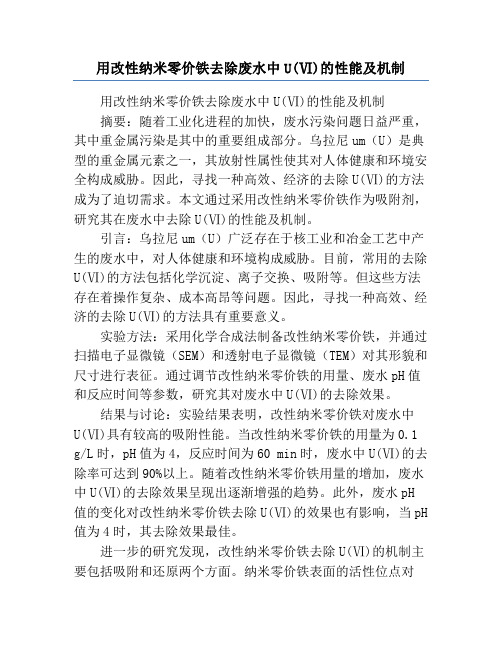
用改性纳米零价铁去除废水中U(Ⅵ)的性能及机制用改性纳米零价铁去除废水中U(Ⅵ)的性能及机制摘要:随着工业化进程的加快,废水污染问题日益严重,其中重金属污染是其中的重要组成部分。
乌拉尼um(U)是典型的重金属元素之一,其放射性属性使其对人体健康和环境安全构成威胁。
因此,寻找一种高效、经济的去除U(Ⅵ)的方法成为了迫切需求。
本文通过采用改性纳米零价铁作为吸附剂,研究其在废水中去除U(Ⅵ)的性能及机制。
引言:乌拉尼um(U)广泛存在于核工业和冶金工艺中产生的废水中,对人体健康和环境构成威胁。
目前,常用的去除U(Ⅵ)的方法包括化学沉淀、离子交换、吸附等。
但这些方法存在着操作复杂、成本高昂等问题。
因此,寻找一种高效、经济的去除U(Ⅵ)的方法具有重要意义。
实验方法:采用化学合成法制备改性纳米零价铁,并通过扫描电子显微镜(SEM)和透射电子显微镜(TEM)对其形貌和尺寸进行表征。
通过调节改性纳米零价铁的用量、废水pH值和反应时间等参数,研究其对废水中U(Ⅵ)的去除效果。
结果与讨论:实验结果表明,改性纳米零价铁对废水中U(Ⅵ)具有较高的吸附性能。
当改性纳米零价铁的用量为0.1 g/L时,pH值为4,反应时间为60 min时,废水中U(Ⅵ)的去除率可达到90%以上。
随着改性纳米零价铁用量的增加,废水中U(Ⅵ)的去除效果呈现出逐渐增强的趋势。
此外,废水pH 值的变化对改性纳米零价铁去除U(Ⅵ)的效果也有影响,当pH 值为4时,其去除效果最佳。
进一步的研究发现,改性纳米零价铁去除U(Ⅵ)的机制主要包括吸附和还原两个方面。
纳米零价铁表面的活性位点对U(Ⅵ)呈现出较高的吸附能力,同时纳米零价铁表面的Fe(0)还原能力能够将U(Ⅵ)还原为U(Ⅳ),从而实现了废水中U(Ⅵ)的去除。
结论:本研究证明,改性纳米零价铁对废水中U(Ⅵ)具有高效的去除效果,并揭示了其去除机制。
这为开发高效、经济的废水处理技术提供了新的思路和方法。
关键词:改性纳米零价铁,废水处理,乌拉尼um(U),吸附,还原综上所述,通过调节改性纳米零价铁的用量、废水pH值和反应时间等参数,本研究发现改性纳米零价铁对废水中U(Ⅵ)具有较高的吸附性能,能够实现废水中U(Ⅵ)的高效去除。
糯米粉负载纳米零价铁去除溶液中U(Ⅵ)的研究
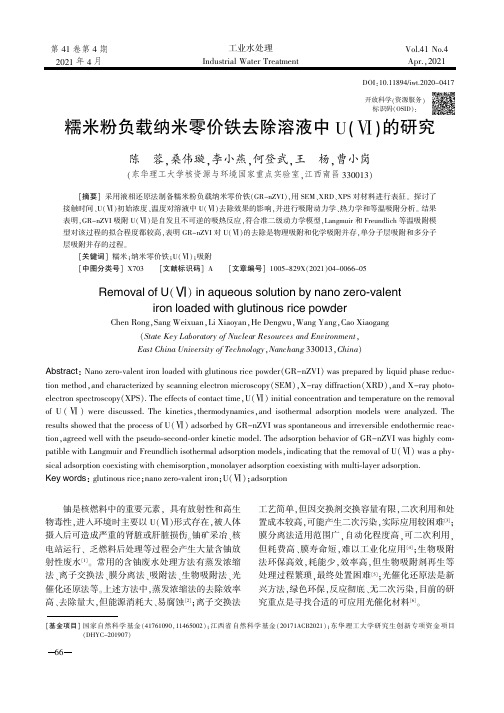
糯米粉负载纳米零价铁去除溶液中U (Ⅵ)的研究陈蓉,桑伟璇,李小燕,何登武,王杨,曹小岗(东华理工大学核资源与环境国家重点实验室,江西南昌330013)[摘要]采用液相还原法制备糯米粉负载纳米零价铁(GR-nZVI ),用SEM 、XRD 、XPS 对材料进行表征。
探讨了接触时间、U (Ⅵ)初始浓度、温度对溶液中U (Ⅵ)去除效果的影响,并进行吸附动力学、热力学和等温吸附分析。
结果表明,GR-nZVI 吸附U (Ⅵ)是自发且不可逆的吸热反应,符合准二级动力学模型,Langmuir 和Freundlich 等温吸附模型对该过程的拟合程度都较高,表明GR-nZVI 对U (Ⅵ)的去除是物理吸附和化学吸附并存,单分子层吸附和多分子层吸附并存的过程。
[关键词]糯米;纳米零价铁;U (Ⅵ);吸附[中图分类号]X703[文献标识码]A[文章编号]1005-829X (2021)04-0066-05Removal of U (Ⅵ)in aqueous solution by nano zero ⁃valentiron loaded with glutinous rice powderChen Rong ,Sang Weixuan ,Li Xiaoyan ,He Dengwu ,Wang Yang ,Cao Xiaogang(State Key Laboratory of Nuclear Resources and Environment ,East China University of Technology ,Nanchang 330013,China )Abstract :Nano zero ⁃valent iron loaded with glutinous rice powder (GR-nZVI )was prepared by liquid phase reduc ⁃tion method ,and characterized by scanning electron microscopy (SEM ),X-ray diffraction (XRD ),and X-ray photo ⁃electron spectroscopy (XPS ).The effects of contact time ,U (Ⅵ)initial concentration and temperature on the removal of U (Ⅵ)were discussed.The kinetics ,thermodynamics ,and isothermal adsorption models were analyzed.The results showed that the process of U (Ⅵ)adsorbed by GR-nZVI was spontaneous and irreversible endothermic reac ⁃tion ,agreed well with the pseudo ⁃second ⁃order kinetic model.The adsorption behavior of GR-nZVI was highly com ⁃patible with Langmuir and Freundlich isothermal adsorption models ,indicating that the removal of U (Ⅵ)was a phy ⁃sical adsorption coexisting with chemisorption ,monolayer adsorption coexisting with multi ⁃layer adsorption.Key words :glutinous rice ;nano zero ⁃valent iron ;U (Ⅵ);adsorption[基金项目]国家自然科学基金(41761090,11465002);江西省自然科学基金(20171ACB2021);东华理工大学研究生创新专项资金项目(DHYC-201907)铀是核燃料中的重要元素,具有放射性和高生物毒性,进入环境时主要以U (Ⅵ)形式存在,被人体摄入后可造成严重的肾脏或肝脏损伤。
电活性镍钴双金属氧化物高选择性去除回收水中磷酸盐离子
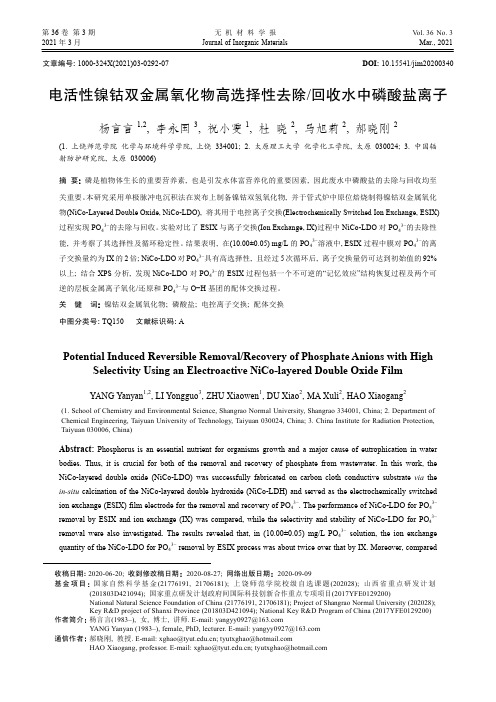
第36卷 第3期 无 机 材 料 学 报Vol. 36No. 32021年3月Journal of Inorganic Materials Mar., 2021收稿日期: 2020-06-20; 收到修改稿日期: 2020-08-27; 网络出版日期: 2020-09-09基金项目: 国家自然科学基金(21776191, 21706181); 上饶师范学院校级自选课题(202028); 山西省重点研发计划(201803D421094); 国家重点研发计划政府间国际科技创新合作重点专项项目(2017YFE0129200)National Natural Science Foundation of China (21776191, 21706181); Project of Shangrao Normal University (202028); Key R&D project of Shanxi Province (201803D421094); National Key R&D Program of China (2017YFE0129200)作者简介: 杨言言(1983–), 女, 博士, 讲师.E-mail:******************YANGYanyan(1983–),female,PhD,lecturer.E-mail:******************通信作者: 郝晓刚, 教授.E-mail:**************.cn;*********************文章编号: 1000-324X(2021)03-0292-07 DOI: 10.15541/jim20200340电活性镍钴双金属氧化物高选择性去除/回收水中磷酸盐离子杨言言1,2, 李永国3, 祝小雯1, 杜 晓2, 马旭莉2, 郝晓刚2(1. 上饶师范学院 化学与环境科学学院, 上饶 334001; 2. 太原理工大学 化学化工学院, 太原 030024; 3. 中国辐射防护研究院, 太原 030006)摘 要: 磷是植物体生长的重要营养素, 也是引发水体富营养化的重要因素, 因此废水中磷酸盐的去除与回收均至关重要。
用改性纳米零价铁去除废水中U(Ⅵ)的性能及机制
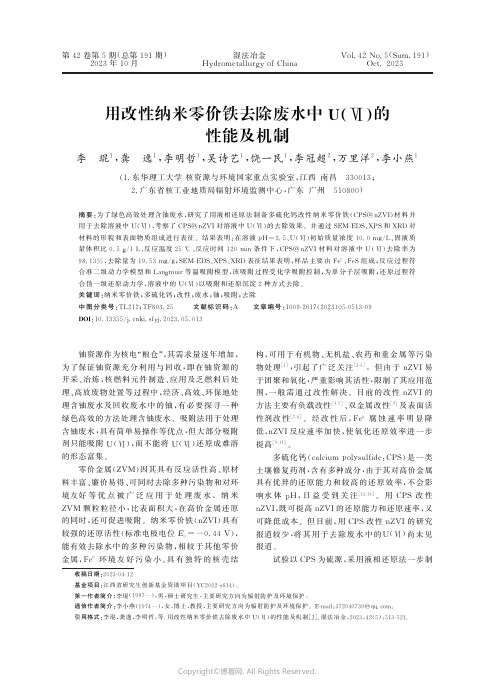
第42卷第5期(总第191期)2023年10月湿法冶金H y d r o m e t a l l u r g y ofC h i n a V o l .42N o .5(S u m.191)O c t .2023用改性纳米零价铁去除废水中U (Ⅵ)的性能及机制李 琨1,龚 逸1,李明哲1,吴诗艺1,饶一民1,李冠超2,万里洋2,李小燕1(1.东华理工大学核资源与环境国家重点实验室,江西南昌 330013;2.广东省核工业地质局辐射环境监测中心,广东广州 510800)摘要:为了绿色高效处理含铀废水,研究了用液相还原法制备多硫化钙改性纳米零价铁(C P S @n Z V I )材料并用于去除溶液中U (Ⅵ),考察了C P S @n Z V I 对溶液中U (Ⅵ)的去除效果㊂并通过S E M -E D S ㊁X P S 和X R D 对材料的形貌和表面物质组成进行表征㊂结果表明:在溶液p H=3.5㊁U (Ⅵ)初始质量浓度10.0m g/L ㊁固液质量体积比0.5g /1L ㊁反应温度25ħ㊁反应时间120m i n 条件下,C P S @n Z V I 材料对溶液中U (Ⅵ)去除率为98.13%,去除量为19.53m g /g;S E M -E D S ㊁X P S ㊁X R D 表征结果表明,样品主要由F e 0㊁F e S 组成;反应过程符合准二级动力学模型和L a n g m u i r 等温吸附模型,该吸附过程受化学吸附控制,为单分子层吸附;还原过程符合伪一级还原动力学,溶液中的U (Ⅵ)以吸附和还原沉淀2种方式去除㊂关键词:纳米零价铁;多硫化钙;改性;废水;铀;吸附;去除中图分类号:T L 212;T F 803.25 文献标识码:A 文章编号:1009-2617(2023)05-0513-09D O I :10.13355/j .c n k i .s f y j.2023.05.013收稿日期:2023-04-12基金项目:江西省研究生创新基金资助项目(Y C 2022-s 614)㊂第一作者简介:李琨(1997 ),男,硕士研究生,主要研究方向为辐射防护及环境保护㊂通信作者简介:李小燕(1974 ),女,博士,教授,主要研究方向为辐射防护及环境保护㊂E -m a i l :372040739@q q.c o m ㊂引用格式:李琨,龚逸,李明哲,等.用改性纳米零价铁去除废水中U (Ⅵ)的性能及机制[J ].湿法冶金,2023,42(5):513-521.铀资源作为核电粮仓 ,其需求量逐年增加,为了保证铀资源充分利用与回收,即在铀资源的开采㊁冶炼,核燃料元件制造㊁应用及乏燃料后处理㊁高放废物处置等过程中,经济㊁高效㊁环保地处理含铀废水及回收废水中的铀,有必要探寻一种绿色高效的方法处理含铀废水㊂吸附法用于处理含铀废水,具有简单易操作等优点,但大部分吸附剂只能吸附U (Ⅵ),而不能将U (Ⅵ)还原成难溶的形态富集㊂零价金属(Z VM )因其具有反应活性高㊁原材料丰富㊁廉价易得㊁可同时去除多种污染物和对环境友好等优点被广泛应用于处理废水㊂纳米Z VM 颗粒粒径小,比表面积大,在高价金属还原的同时,还可促进吸附㊂纳米零价铁(n Z V I )具有较强的还原活性(标准电极电位E 0=-0.44V ),能有效去除水中的多种污染物,相较于其他零价金属,F e环境友好污染小㊁具有独特的核壳结构,可用于有机物㊁无机盐㊁农药和重金属等污染物处理[1],引起了广泛关注[2-3]㊂但由于n Z V I 易于团聚和氧化,严重影响其活性,限制了其应用范围,一般需通过改性解决㊂目前的改性n Z V I 的方法主要有负载改性[4-5]㊁双金属改性[6]及表面活性剂改性[7-8]㊂经改性后,F e腐蚀速率明显降低,n Z V I 反应速率加快,使氧化还原效率进一步提高[9-11]㊂多硫化钙(c a l c i u m p o l ys u l f i d e :C P S )是一类土壤修复药剂,含有多种成分,由于其对高价金属具有优异的还原能力和较高的还原效率,不会影响水体p H ,日益受到关注[12-14]㊂用C P S 改性n Z V I ,既可提高n Z V I 的还原能力和还原速率,又可降低成本㊂但目前,用C P S 改性n Z V I 的研究报道较少,将其用于去除废水中的U (Ⅵ)尚未见报道㊂试验以C P S 为硫源,采用液相还原法一步制Copyright ©博看网. All Rights Reserved.湿法冶金2023年10月备多硫化钙改性纳米零价铁(C P S@n Z V I),并研究了C P S@n Z V I去除废水中U(Ⅵ)的性能和机制,以期为去除废水中U(Ⅵ)及土壤中高价金属污染修复提供一种环保经济的修复材料㊂1试验部分1.1试验原料㊁试剂及仪器含U(Ⅵ)溶液:依据待处理废水成分,用U(Ⅵ)标溶液按比例配制,U(Ⅵ)初始质量浓度10.0m g/L㊂试验试剂:无水乙醇㊁六水合三氯化铁(F e C l3㊃6H2O),西陇化工股份有限公司;硝酸(H N O3)㊁盐酸(H C l)㊁29%多硫化钙溶液,连云港兰星工业技术有限公司;八氧化三铀(U3O8)㊁氢氧化钠(N a O H)㊁硼氢化钾(K B H4),天津科密欧化学试剂有限公司;超纯水(尼珂超纯水L T-B F10)㊁偶氮胂Ⅲ(铀试剂Ⅲ)㊁2-4-二硝基苯酚㊂以上试剂均为分析纯㊂试验仪器:电子天平(C P124C),p H计(p H S-3C),数控超声波仪(K Q-100D E),磁力搅拌器,水浴恒温振荡箱,离心机(T D L-40B),分光光度计(722),真空干燥箱(D Z F-6020)㊂1.2材料制备称取0.54g F e C l3㊃6H2O溶于50m L超纯水中,加入1.02g多硫化钙溶液于烧杯中搅拌均匀,称取0.378g K B H4用玻璃棒搅拌溶解于50m L超纯水中,用一次性滴管缓慢滴加到多硫化钙与三氯化铁混合溶液中,滴加完毕后反应15m i n,至溶液中再无气泡产生㊂所得黑色固体样品用超纯水和无水乙醇洗涤,待样品离心后置于真空干燥箱内在65ħ保持12h,干燥后研磨样品得C P S@n Z V I材料,备用㊂1.3U(Ⅵ)的去除用盐酸和氢氧化钠调节U(Ⅵ)溶液p H,量取25m L质量浓度10.0m g/L含U(Ⅵ)溶液于锥形瓶中,加入一定质量C P S@n Z V I样品,将锥形瓶放入振荡箱中反应一定时间,然后取出锥形瓶内溶液离心,用分光光度计测定上清液中U(Ⅵ)质量浓度,U(Ⅵ)吸附量及去除率计算公式如下:q=(ρ0-ρe)Vm;(1)r=ρ0-ρeρ0ˑ100%㊂(2)式中:q U(Ⅵ)吸附量,m g/g;r U(Ⅵ)去除率,%;ρ0㊁ρe U(Ⅵ)反应前㊁反应平衡后溶液中U(Ⅵ)质量浓度,m g/L;V 溶液体积,L;mC P S@n Z V I投加量,g㊂1.4等温吸附量取25m L不同初始质量浓度(10㊁15㊁20㊁25㊁30㊁35㊁40m g/L)的含U(Ⅵ)溶液,p H=3.5,加入C P S@n Z V I,设定固液质量体积比为0.5g/1L,在不同温度下(293㊁298㊁303㊁308K)水浴反应120m i n,由所得试验数据计算去除率并绘制相关曲线㊂1.5反应动力学研究将C P S@n Z V I加入含U(Ⅵ)溶液中,溶液体积25m L,固液质量体积比0.5g/1L㊂调节溶液p H=3.5,不同温度下(293㊁298㊁303㊁308K)水浴反应不同时间,由所得数据绘制相应图表㊂2试验结果与讨论2.1C P S@n Z V I的表征采用S E M-E D S㊁X P S和X R D等分析手段研究C P S@n Z V I形貌特征及表面物质组成㊂2.1.1形貌和元素组成分析(S E M-E D S)C P S@n Z V I反应前㊁后S E M-ED S图谱如图1所示㊂由图1(a)看出,C P S@n Z V I表面呈块状结构,存在小碎块,与F e0相比,团聚现象明显改善[15];由图1(b)看出,反应后样品表面变得疏松粗糙并有不规则颗粒物堆积;由图1(c)看出,用多硫化钙改性后,C P S@n Z V I的元素组成主要为F e㊁C a㊁S㊁O;由图1(d)看出:反应后C P S@n Z V I 中出现U元素,表明U已经被吸附至样品表面㊂2.1.2X射线光电子能谱分析(X P S)C P S@n Z V I反应前㊁后的X P S图谱如图2所示㊂㊃415㊃Copyright©博看网. All Rights Reserved.第42卷第5期李琨,等:用改性纳米零价铁去除废水中U (Ⅵ)的性能及机制a 反应前S E M ;b 反应后S E M ;c 反应前E D S ;d 反应后E D S㊂图1 C P S @n Z V I 反应前㊁后的S E M -E D S图谱a 全谱;b S2p ;c F e 2p ;d U4f ㊂图2 C P S @n Z V I 反应前㊁后的X P S 图谱由图2(a )看出:C P S@n Z V I 中含有5种元素:F e ㊁O ㊁C a ㊁C ㊁S ,其中C 元素是作为污染源进行校正㊂反应后样品中检测出U 元素㊂由图2(b)看出:反应前样品中含有多种硫化物,从S2p 主要峰位看出,在结合能为161.18e V 和162.28e V 处出现的吸收峰为S2-(单硫化物)的特征峰[16],在结合能为162.92e V 和164.02e V 处出现的吸收峰为S 2-n (多硫化物)特征峰[17],在结合能为167.95e V 和169.05e V 处出现的吸收峰为S O 2-3的特征峰,其中S 2-n 和S O 2-3是S 2-的氧化产物,反应后样品中S 2-特征峰消失,S O 2-3特征峰向高结合能偏移,表明失去电子,形成S O 2-4及其卫星峰[16]㊂㊃515㊃Copyright ©博看网. All Rights Reserved.湿法冶金 2023年10月由图2(c )看出:反应前,在结合能为708.30e V和710.93e V 处出现的吸收峰为F e 0和F e 3+的特征峰,在结合能为721.10e V 和723.73e V 处出现的吸收峰分别为卫星峰和F e 2+的特征峰㊂反应后,在结合能为711.31e V 和724.54e V 处出现的吸收峰均为F e3+的特征峰,在结合能719.57e V 处出现的吸收峰为F e S 的特征峰,这是由于随反应进行,原本被零价铁和铁氧化物包裹的F e S 逐渐出现在样品表面[18]㊂根据反应前后对比可知,主要由F e 0与U (Ⅵ)反应生成F e 2+和U (Ⅳ),F e 2+与U (Ⅵ)再反应生成U (Ⅳ)和F e3+㊂在结合能为714.50㊁727.30e V 和732.37e V 处出现的吸收峰均为卫星峰,说明该反应主要由F e0和S 2-提供电子,自身则被氧化[16,19]㊂由图2(d )看出:在结合能为381.34e V 和392.04e V 处出现的吸收峰为U4f 7/2和U4f5/2的特征峰,均为U (Ⅳ)的吸收峰[20],结合S E M -E D S 表征和图4(c )中F e特征峰消失,推测C P S @n Z V I 样品先将U (Ⅵ)吸附至表面还原成U (Ⅳ)[21]㊂2.1.3 晶相结构及物质组成分析(X R D )C P S @n Z V I 与U (Ⅵ)反应前㊁后的X RD 图谱如图3所示㊂图3 C P S @n Z V I 与U (Ⅵ)反应前㊁后的X R D 图谱由图3看出:反应前,C P S@n Z V I 在2θ=45.04ʎ㊁49.34ʎ出现特征峰,与F e标准卡(P D F #06-0696)(110)晶面衍射角和F e 2O 3标准卡(P D F#33-0664)(024)晶面衍射角一致[22-23],可能由于制备或者送样检测过程中被氧化㊂反应后,C P S @n Z V I 在2θ=35.36ʎ㊁43.62ʎ出现特征峰,与F e 3O 4标准卡(P D F #19-0629)(311)(400)晶面的衍射角一致[24],F e 0峰消失和X P S 结果分析相吻合,表明样品中的F e 0被氧化腐蚀为F e3+㊂2.2 U (Ⅵ)的去除2.2.1 硫铁物质的量比对去除U (Ⅵ)的影响在溶液p H=5.0㊁U (Ⅵ)质量浓度10.0m g/L ㊁C P S @n Z V I 用量10m g 条件下,考察不同硫铁物质的量比所制备的C P S @n Z V I 对U (Ⅵ)去除率的影响,试验结果如图4所示㊂图4 硫铁物质的量比对U (Ⅵ)去除率的影响 由图4看出:S 的含量对零价铁去除U (Ⅵ)有明显影响,其中硫铁物质的量比为2ʒ1时,U (Ⅵ)去除率最高㊂在此条件下,可降低铁的用量,说明S 的加入能有效抑制C P S@n Z V I 团聚和氧化,加快n Z V I 反应速率,抑制副反应发生,增强材料稳定性;但过量S 会减少F e0的生成并形成钝化膜阻止反应进行,不利于U (Ⅵ)的去除㊂因此,确定选择以硫铁物质的量比2ʒ1制备C P S @n Z V I样品进行后续试验㊂2.2.2 溶液p H 和反应时间对去除U (Ⅵ)的影响在反应温度25ħ㊁U (Ⅵ)质量浓度10.0m g/L ㊁固液质量体积比0.5g /1L 条件下,溶液p H 和反应时间对C P S @n Z V I 去除U (Ⅵ)的影响试验结果如图5所示,电位-p H 变化曲线如图6所示㊂由图5(a )看出:从p H=2.5开始,随p H 增大,U (Ⅵ)去除率逐渐升高;pH 增至3.5时,U (Ⅵ)去除率达最大;之后随p H 升高,U (Ⅵ)去除率小幅下降,但仍大于90%㊂由图5(b )看出:随反应时间延长,不同p H 下U (Ⅵ)去除率均升高,反应120m i n 后升高幅度变小㊂在p H 较低时,铀主要以U O 2+2形式存在,结合图6看出:C P S@n Z V I 的等电位点位于p H=3.5左右,在p H=3.5~6.0范围内,电位绝对值大,说明该材料在该p H 范围内稳定性较好;pH 低于3.5时,材料表面带有正电荷,会发生高浓度H +与U O 2+2之间的竞㊃615㊃Copyright ©博看网. All Rights Reserved.第42卷第5期李琨,等:用改性纳米零价铁去除废水中U (Ⅵ)的性能及机制争吸附,从而影响材料吸附能力,C P S @n Z V I 中的F e0易被H +腐蚀,使反应活性位点减少,导致U (Ⅵ)去除率降低;pH 高于3.5时,材料表面带有负电荷,H +离子强度降低,与U O 2+2的竞争吸附作用减弱,有利于U O 2+2吸附㊂随p H 进一步升高,铀的存在形态转变为碳酸铀酰(离子),碳酸铀酰(离子)是一种稳定的配合物,导致C P S @n Z V I 对铀的吸附亲和力降低,对铀去除性能下降㊂因此,确定最佳p H 为3.5㊂图5 溶液p H 和反应时间对去除U (Ⅵ)效果的影响图6 电位-pH 变化曲线2.3 吸附动力学C P S @n Z V I 对U (Ⅵ)的吸附动力学曲线如图7所示,采用准一级㊁准二级动力学模型对试验数据进行拟合,拟合曲线如图8所示,拟合参数见表1㊂准一级㊁准二级动力学模型[25]如下:l n (q e -q t )=l n q e -k 1t ;(3)t q t =1k 2q 2e +t q e ㊂(4)式中:q e ㊁qt 反应平衡时的吸附量和t 时的吸附量,m g /g ;k 1 准一级动力学常数,m i n -1;k 2 准二级动力学常数,g /(m g㊃m i n )㊂由图7看出:温度ȡ298K 时,吸附前30m i n,U (Ⅵ)吸附量快速升高,之后减缓,最终达吸附平衡㊂这是由于反应前期,材料表面的活性位点较多,有利于U (Ⅵ)的快速还原和吸附,同时溶液中U (Ⅵ)离子浓度较高,更易于与材料接触㊁发生反应并吸附在表面;反应后期,随材料表面F e 0的消耗,越来越多的表面活性位点逐渐被占据,同时F e 0与U O 2+2反应后生成铁和铀的氢氧化物,阻止反应进行,因此反应后期主要以吸附方式去除U (Ⅵ),去除率升幅缓慢㊂温度ȡ298K 时,升高温度对U (Ⅵ)吸附量变化不大,随反应时间延长,U (Ⅵ)吸附量持续升高直至达到平衡㊂图7 C P S @n Z V I 对U (Ⅵ)的吸附动力学曲线由图8㊁表1看出:C P S @n Z V I 对U (Ⅵ)的吸附过程符合准二级动力学,相关系数R 2都在0.9以上,拟合计算所得理论最大吸附量与试验所得吸附量较为接近,其吸附过程符合化学吸附,说明C P S @n Z V I 与U (Ⅵ)的吸附过程存在电子转移㊁交换或共享㊂结合X P S 表征结果可知,反应前期C P S @n Z V I 样品先将U (Ⅵ)吸附至表面进行还原沉淀,反应后期以化学吸附方式去除U (Ⅵ)㊂㊃715㊃Copyright ©博看网. All Rights Reserved.湿法冶金 2023年10月图8 准一级(a )㊁准二级(b)吸附动力学拟合曲线表1 吸附动力学拟合参数T /K 准一级动力学模型准二级动力学模型qe /(m g ㊃g -1)k 1/m i n -1R2qe /(m g ㊃g -1)k 2/(g ㊃m g -1㊃m i n -1)R229316.980.02150.74346.530.00230.9452989.190.02680.92237.330.00500.9963031.990.01940.40451.680.02410.9993081.680.01190.12483.750.03900.9992.4 还原动力学在弱酸性环境下,铀主要以U O 2+2形式存在,U O 2+2会被F e 0还原成难溶U O 2㊂CP S @n Z V I 对U (Ⅵ)的还原速率曲线如图9所示㊂图9 C P S @n Z V I 对U (Ⅵ)的还原速率曲线 由图9看出:反应前20m i n ,C P S @n Z V I 对U (Ⅵ)还原速率比反应20m i n 后更快,因为在反应初始阶段,C P S @n Z V I 比表面积更大,表面吸附能力较强,反应前期主要由F e快速还原U O 2+2,这时还原速率远大于吸附速率;随反应进行,样品表面F e有一定程度消耗,其表面附着铁与铀的氢氧化物阻碍还原反应进行,导致还原速率下降,这时主要以吸附方式去除U (Ⅵ)㊂L a n gm u i r -H i n s h e l w o o d 动力学模型[26]方程式如下:v =-d ρd t =k b ρ1+b ρ㊂(5)式中:v 还原反应速率,m g /(L ㊃m i n );t 反应时间,m i n ;k 固体表面反应速率常数,m i n-1;b 吸附常数;ρ U (Ⅵ)质量浓度,m g /L ㊂当反应物浓度较低时(b ρ≪1),式(5)可简化为v =-d ρd t=k b ρ=k o b s ρ,(6)式中,k o b s =k b ,此时反应简化为伪一级反应㊂对式(6)积分,l n (ρt /ρ0)与t 呈线性关系:l n ρtρ=-k o b st ,(7)式中,k o b s 表观速率常数,m i n -1㊂采用L a n gm u i r -H i n s h e l w o o d 动力学模型对图9中试验数据进行分析,绘制l n (ρt /ρ0)-t 散点图,并对前20m i n 试验数据进行拟合,结果如图10所示,拟合参数见表2㊂由图10看出,在整个反应时间范围(0~160m i n )内,l n (ρt /ρ0)与t 不存在线性关系,其反应过程不符合伪一级还原动力学模型;但在反应前20m i n ,反应温度分别为298㊁303㊁308K时,相关系数R 2分别为0.92,0.76,0.97,说明反应前20m i n ,l n (ρt /ρ0)与t 存在线性关系,即C P S @n Z V I 在反应前20m i n 符合伪一级还原动力学模型㊂㊃815㊃Copyright ©博看网. All Rights Reserved.第42卷第5期李琨,等:用改性纳米零价铁去除废水中U (Ⅵ)的性能及机制a 散点图;b拟合曲线㊂图10 l n (ρt /ρ0)-t 的关系曲线表2 还原动力学拟合参数T /K k o b s/m i n -1R22980.11790.923030.09680.763080.12650.972.5 吸附等温线称取一定量C P S @n Z V I 样品分别加入至体积25m L ㊁pH=3.5的含U (Ⅵ)溶液中,在固液质量体积比0.5g /1L ㊁温度25ħ条件下,考察U (Ⅵ)初始质量浓度对U (Ⅵ)去除效果的影响,试验结果如图11所示㊂可以看出:随U (Ⅵ)初始质量浓度增大,U (Ⅵ)去除量升高,去除率逐渐降低㊂这是由于材料表面的反应活性位点数量一定,当位点被完全占据后,材料很难再吸附U (Ⅵ),导致随U (Ⅵ)初始质量浓度增大,U (Ⅵ)去除率降低而去除量升高㊂采用L a n gm u i r 及F r e u n d l i c h 等温吸附模型对所得数据进行拟合,分别在不同温度下恒温振荡反应2h ,拟合曲线如图12所示,拟合参数见表3㊂L a n gm u i r 和F r e u n d l i c h 等温吸附模型[27]公式如下:ρe q e =ρe q m +1k L qm ;(8)l n q e=l n k F +1n l n ρe ㊂(9)式中:ρe 反应平衡时U (Ⅵ)质量浓度,m g /L ;q e ㊁qm 平衡吸附量㊁最大吸附量,m g /g ;k L L a n g m u i r 等温吸附平衡常数,L /m g ;k F F r e u n d l i c h 等温吸附平衡常数,L /g㊂图11 U (Ⅵ)初始质量浓度对U (Ⅵ)去除效果的影响图12 L a n gm u i r (a )㊁F r e u n d l i c h (b )等温吸附拟合曲线㊃915㊃Copyright ©博看网. All Rights Reserved.湿法冶金2023年10月表3等温吸附模型拟合参数T/K L a n g m i u r等温吸附模型F r e u n d l i c h等温吸附模型q m/(m g㊃g-1)k L/(L㊃m g-1)R2k F/(L㊃g-1)1/n R2 29335.158.03670.915518.66970.26400.3642 29859.070.95380.916332.08860.21910.7265 30373.420.51280.914133.26480.24480.3887 30874.910.42000.942527.05170.34740.9002由表3看出:相较于F r e u n d l i c h等温吸附模型,L a n g m u i r等温吸附模型的线性拟合程度更好,相关系数R2更接近1,说明该C P S@n Z V I对U(Ⅵ)的吸附过程更符合L a n g m u i r等温吸附模型,即吸附过程是单分子层吸附,且在F r e u n d l i c h 等温吸附模型相关参数计算中,1/n均小于1,表明该吸附过程较易进行[28]㊂3结论1)利用液相还原法可一步制备多硫化钙改性纳米零价铁(C P S@n Z V I)材料㊂与n Z V I相比,C P S@n Z V I的F e0团聚现象明显改善㊂C P S@n Z V I中的铁主要由F e0㊁F e S组成,对U(Ⅵ)的去除以吸附和还原沉淀2种方式实现,反应前期为快速的还原沉淀,后期主要以吸附方式进行㊂2)在U(Ⅵ)初始质量浓度10.0m g/L㊁溶液p H=3.5㊁硫铁物质的量比2ʒ1㊁固液质量体积比0.5g/1L㊁反应温度25ħ㊁反应时间为120m i n 条件下,C P S@n Z V I对溶液中U(Ⅵ)的去除率达98.13%,吸附量达19.53m g/g㊂3)C P S@n Z V I对U(Ⅵ)的吸附过程更符合准二级动力学模型和L a n g m u i r等温吸附模型,即吸附过程属于化学吸附速率控制过程,是表面单分子层吸附㊂参考文献:[1] T A N G H,WA N GJ,Z HA N G S,e ta l.R e c e n ta d v a n c e s i nn a n o s c a l ez e r o-v a l e n t i r o n-b a s e d m a t e r i a l s:c h a r a c t e r i s t i c s,e n v i r o n m e n t a lr e m e d i a t i o n a n dc h a l l e n g e s[J].J o u r n a lo fC l e a n e rP r o d u c t i o n,2021,319.D O I:10.1016/j.j c l e p r o.2021.128641.[2] WU Y,G U A N C Y,G R I S WO L D N,e ta l.Z e r o-v a l e n ti r o n-b a s e d t e c h n o l o g i e s f o rr e m o v a l o fh e a v y m e t a l(l o i d)sa n do r g a n i c p o l l u t a n t s f r o mt h e a q u a t i c e n v i r o n m e n t:r e c e n ta d v a n c e s a n d p e r s p e c t i v e s[J].J o u r n a lo fC l e a n e rP r o d u c t i o n,2020,277.D O I:10.1016/j.j c l e p r o.2020.123478. [3] G O N G Y,WA N G Y,L I N N,e t a l.I r o n-b a s e dm a t e r i a l s f o rs i m u l t a n e o u s r e m o v a l o fh e a v y m e t a l(l o i d)sa n de m e r g i n g o r g a n i c c o n t a m i n a n t s f r o mt h ea q u a t i ce n v i r o n m e n t:r e c e n ta d v a n c e sa n d p e r s p e c t i v e s[J].E n v i r o n m e n t a l P o l l u t i o n,2022.D O I:10.1016/j.e n v p o l.2022.118871.[4] L I U F,L O U Y,X I A F,e ta l.I m m o b i l i z i n g n Z V I p a r t i c l e so n M B e n e s t o e n h a n c e t h e r e m o v a l o fU(Ⅵ)a n dC r(Ⅵ)b ya d s o r p t i o n-r e d u c t i o n s y n e r g i s t i c e f f e c t[J].C h e m i c a l E n g i n e e r i n gJ o u r n a l,2023,454.D O I:10.1016/j.c e j.2022.140318. [5]桑伟璇,陈蓉,李小燕,等.玉米淀粉负载型纳米零价铁去除溶液中U(Ⅵ)研究[J].有色金属(冶炼部分),2020(8): 92-98.[6]刘晴晴,李小燕,秦启凤,等.纳米铁镍双金属去除溶液中U(Ⅵ)的性能研究[J].有色金属(冶炼部分),2018(7):74-78.[7] L I J,F A N M,L IM,e t a l.C r(Ⅵ)r e m o v a l f r o m g r o u n d w a t e ru s i n g d o u b l e s u r f a c t a n t-m o d i f i e dn a n o s c a l ez e r o-v a l e n t i r o n (n Z V I):e f f e c t so fm a t e r i a l s i nd i f f e r e n ts t a t u s[J].S c i e n c e o ft h e T o t a l E n v i r o n m e n t,2020,717.D O I:10.1016/j.s c i t o t e n v.2020.137112.[8] K E N D S,S I N HA A.R e c e n t d e v e l o p m e n t si n s u r f a c em o d i f i c a t i o no fn a n oz e r o-v a l e n t i r o n(n Z V I):r e m e d i a t i o n, t o x i c i t y a n d e n v i r o n m e n t a li m p a c t s[J].E n v i r o n m e n t a l N a n o t e c h n o l o g y,M o n i t o r i n g&M a n a g e m e n t,2020,14.D O I:10.1016/j.e n m m.2020.100344.[9] D A IY,D U A NL,D U W,e t a l.M o r p h o l o g y a n d s t r u c t u r e o fi ns i t uF e Sa f f e c tC r(Ⅵ)r e m o v a l b y s u l f i d a t e d m i c r o s c a l ez e r o-v a l e n t i r o n w i t h s h o r t-t e r m u l t r a s o n i c a t i o n[J].C h e m o s p h e r e,2022,290.D O I:10.1016/j.c h e m o s p h e r e.2021.133372.[10]刘清,刘欢,招国栋,等.硫化纳米零价铁在水环境修复中的研究进展[J].应用化工,2021,50(5):1330-1334. [11] L I A N G L,L I X,G U O Y,e ta l.T h er e m o v a lo fh e a v ym e t a lc a t i o n s b y s u l f i d a t e d n a n o s c a l e z e r o-v a l e n ti r o n(S-n Z V I):t h e r e a c t i o n m e c h a n i s m sa n dt h er o l eo f s u l f u r[J].J o u r n a lo fH a z a r d o u s M a t e r i a l s,2021,404.D O I:10.1016/j.j h a z m a t.2020.124057.[12] C H R Y S O C H O O U M,T I N G A.Ak i n e t i c s t u d y o fC r(Ⅵ)r e d u c t i o nb y c a l c i u m p o l y s u l f i d e[J].S c i e n c eo f t h eT o t a lE n v i r o n m e n t,2011,409(19):4072-4077.[13] Z HA N G T,WA N G T,WA N G W,e ta l.R e d u c t i o na n ds t a b i l i z a t i o no f C r(Ⅵ)i n s o i l b y u s i n g c a l c i u m p o l y s u l f i d e:C a t a l y s i s o f n a t u r a l i r o n o x i d e s[J].E n v i r o n m e n t a l㊃025㊃Copyright©博看网. All Rights Reserved.第42卷第5期李琨,等:用改性纳米零价铁去除废水中U (Ⅵ)的性能及机制R e s e a r c h ,2020,190.D O I :10.1016/j .e n v r e s .2020.109992.[14] 朱巧红,李明,程寒飞.多硫化钙修复C r (Ⅵ)污染土壤和地下水的研究进展[J ].安徽农学通报,2019,25(9):126-128.[15] 高国振,李金轩,李小燕,等.纳米零价铁/玉米淀粉的制备及其对P b 2+的吸附[J ].化工环保,2014,34(4):376-379.[16] 徐步德.硫化的铁基纳米复合材料的制备及去除水中氯代有机物的研究[D ].合肥:中国科学技术大学,2020.[17] 魏子斐.硫化零价铁 炭复合材料的球磨制备及其对氯代烃的降解研究[D ].绵阳:西南科技大学,2022.[18] 王金鑫.多硫化钙改性纳米零价铁对水中三氯乙烯的去除效果研究[D ].长春:吉林大学,2020.[19] 李盟.空气氛围下制备硫化纳米零价铁及其对水中C r (Ⅵ)和4-硝基酚的去除研究[D ].上海:上海第二工业大学,2021.[20] 何登武.乳化纳米零价铁/胶体M g (O H )2复合材料去除溶液中U (Ⅵ)的效能与机制[D ].南昌:东华理工大学,2022.[21] 刘欢.硫化型绿色纳米零价铁对水中U (Ⅵ)的去除机理研究[D ].衡阳:南华大学,2021.[22] 陈海峰,张路萍.碳改性纳米零价铁对水中六价铬的强化吸附还原[J ].安全与环境学报,2022.D O I :10.13637/j.i s s n .1009-6094.2022.2258.[23] 高芳,别祉睿,谭赛娅,等.Z n O /α-F e 2O 3复合材料对偶氮染料的降解[J ].化工环保,2023,43(1),113-118.[24] 吕智慧,党力,张忠楠,等.F e 3O 4@M g (O H )2磁性复合材料吸附去除水中N i 2+的研究[J ].青海大学学报,2022,40(5):9-17.[25] 王扬,牛洁,徐乐昌,等.载铁生物炭的制备及其在含铀矿井水处理中的应用[J ].湿法冶金,2021,40(4):310-314.[26] 马少云,祝方,商执峰.纳米零价铁铜双金属对铬污染土壤中C r (Ⅵ)的还原动力学[J ].环境科学,2016,37(5):1953-1959.[27] 何余生,李忠,奚红霞,等.气固吸附等温线的研究进展[J ].离子交换与吸附,2004,20(4):376-384.[28] 王攀峰.改性蒙脱土对铀(Ⅵ)的吸附研究[D ].南昌:东华理工大学,2016.P r o p e r t i e s a n dM e c h a n i s mo fU (Ⅵ)R e m o v a l f r o m A q u e o u s S o l u t i o nb y Mo d i f i e d N a n oZ e r o -v a l e n t I r o nL IK u n 1,G O N G Y i 1,L IM i n g z h e 1,WUS h i yi 2,R A O Y i m i n 1,L IG u a n c h a o 2,WA N L i y a n g 1,L IX i a o ya n 1(1.S t a t eK e y L a b o r a t o r y o f N u c l e a rR e s o u r c e s a n dE n v i r o n m e n t ,E a s t C h i n aU n i v e r s i t y o f T e c h n o l o g y ,N a n c h a n g 330013,C h i n a ;2.R a d i a t i o nE n v i r o n m e n tM o n i t o r i n g C e n t e r o f G u a n g d o n g G e o l o g i c a lB u r e a u o f N u c l e a r I n d u s t r y ,G u a n gz h o u 510800,C h i n a )A b s t r a c t :I no r d e rt ot r e a tu r a n i u m c o n t a i n i n g w a s t e w a t e r w i t h g r e e na n dh i g he f f i c i e n c y,c a l c i u m p o l y s u l f i d em o d i f i e dn a n o -f e r r i cz e r o (C P S@n Z V I )m a t e r i a lw a s p r e p a r e db y l i qu i d p h a s er e d u c t i o n m e t h o d a n du s e d f o r r e m o v i n g U (Ⅵ)i ns o l u t i o n .T h er e m o v a l e f f e c t so fC P S@n Z V Io n U (Ⅵ)i n s o l u t i o nw e r e i n v e s t i g a t e d .S E M -E D S ,X P Sa n dX R D w e r eu s e dt oc h a r a c t e r i z et h e m o r p h o l o g y an d s u r f a c e c o m po s i t i o no f t h em a t e r i a l s .T h e r e s u l t s s h o wt h a t u n d e r t h e c o n d i t i o n s o f s o l u t i o n p H=3.5,U (Ⅵ)i n i t i a lm a s s c o n c e n t r a t i o no f 10.0m g /L ,s o l i dm a s s -l i qu i dv o l u m e r a t i oo f 0.5g /1L ,r e a c t i o n t e m pe r a t u r e of 25ħa n d r e a c t i o n t i m e o f 120m i n ,t h eU (Ⅵ)r e m o v a l r a t e o fC P S @n Z V Im a t e r i a l i n t h ew a s t e w a t e r i s 98.13%,a n d t h e r e m o v a l a m o u n t i s 19.53mg /g .S E M -E D S ,X P Sa n dX R Dr e s u l t s sh o wt h a t t h es a m p l e sa r e m ai n l y c o m po s e do fF e 0a n dF e S .T h er e a c t i o n p r o c e s sc o n f o r m st ot h e q u a s i -s e c o n d -o r d e r k i n e t i cm o d e l a n d t h eL a n g m u i r i s o t h e r m a l a d s o r pt i o nm o d e l ,w h i c h i n d i c a t e s t h a t t h e a d s o r p t i o n p r o c e s s i s c o n t r o l l e d b y c h e m i s o p r t i o n a n dm o n o l a y e r a d s o r pt i o n .T h e r e d u c t i o n p r o c e s s c o n f o r m s t o t h e p s e u d o -f i r s t -o r d e r r e d u c t i o nk i n e t i c s ,i n d i c a t i n g t h a tU (Ⅵ)i ns o l u t i o n i s r e m o v e db y a d s o r p t i o na n d r e d u c t i o n p r e c i pi t a t i o n .K e y wo r d s :n a n o -z e r o v a l e n t i r o n ;c a l c i u m p o l y s u l f i d e ;m o d i f i c a t i o n ;w a s t e w a t e r ;U (Ⅵ);a d s o r p t i o n ;r e m o v a l ㊃125㊃Copyright ©博看网. All Rights Reserved.。
《2024年镍基异质结纳米材料的构建及其电催化全解水性能研究》范文
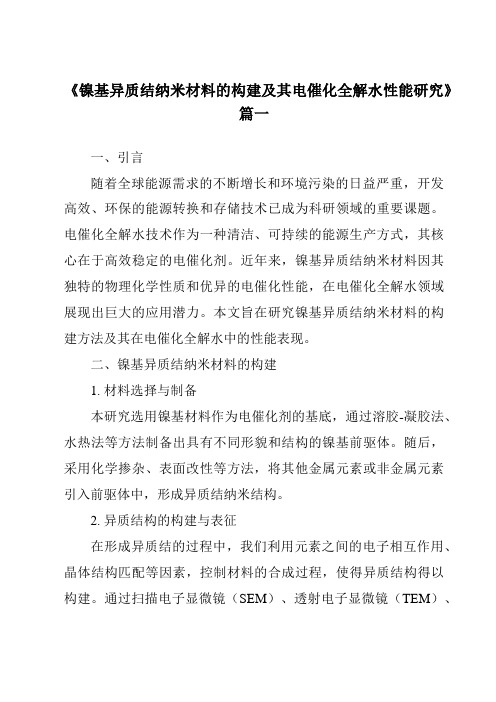
《镍基异质结纳米材料的构建及其电催化全解水性能研究》篇一一、引言随着全球能源需求的不断增长和环境污染的日益严重,开发高效、环保的能源转换和存储技术已成为科研领域的重要课题。
电催化全解水技术作为一种清洁、可持续的能源生产方式,其核心在于高效稳定的电催化剂。
近年来,镍基异质结纳米材料因其独特的物理化学性质和优异的电催化性能,在电催化全解水领域展现出巨大的应用潜力。
本文旨在研究镍基异质结纳米材料的构建方法及其在电催化全解水中的性能表现。
二、镍基异质结纳米材料的构建1. 材料选择与制备本研究选用镍基材料作为电催化剂的基底,通过溶胶-凝胶法、水热法等方法制备出具有不同形貌和结构的镍基前驱体。
随后,采用化学掺杂、表面改性等方法,将其他金属元素或非金属元素引入前驱体中,形成异质结纳米结构。
2. 异质结构的构建与表征在形成异质结的过程中,我们利用元素之间的电子相互作用、晶体结构匹配等因素,控制材料的合成过程,使得异质结构得以构建。
通过扫描电子显微镜(SEM)、透射电子显微镜(TEM)、X射线衍射(XRD)等手段对所制备的镍基异质结纳米材料进行表征,以确定其形貌、结构和成分。
三、电催化全解水性能研究1. 电极制备与电化学测试将所制备的镍基异质结纳米材料制成工作电极,采用标准的三电极体系进行电化学测试。
在电催化全解水中,我们关注的关键指标包括起始电位、电流密度以及塔菲尔斜率等。
通过循环伏安法(CV)和线性扫描伏安法(LSV)等手段,对所制备的电极进行性能评估。
2. 性能分析与优化通过对电化学测试结果的分析,我们发现镍基异质结纳米材料在电催化全解水中表现出优异的性能。
在此基础上,我们进一步优化了材料的制备工艺和结构设计,以提高其电催化性能。
例如,通过调整掺杂元素的种类和含量、控制材料的形貌和尺寸等因素,实现了对电催化性能的有效调控。
四、结果与讨论1. 实验结果总结本研究成功构建了多种镍基异质结纳米材料,并通过电化学测试对其在电催化全解水中的性能进行了评估。
纳米零价铁去除水中六价铬的研究
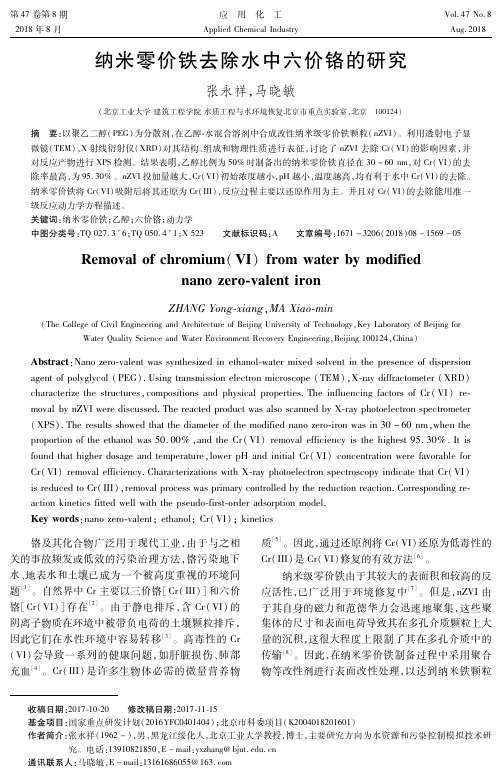
应 用 化 工 AppliedChemicalIndustry
Vol.47No.8 Aug.2018
纳米零价铁去除水中六价铬的研究
张永祥,马晓敏
(北京工业大学 建筑工程学院 水质工程与水环境恢复北京市重点实验室,北京 100124)
摘 要:以聚乙二醇(PEG)为分散剂,在乙醇水混合溶剂中合成改性纳米级零价铁颗粒(nZVI)。利用透射电子显 微镜(TEM),X射线衍射仪(XRD)对其结构、组成和物理性质进行表征,讨论了 nZVI去除 Cr(VI)的影响因素,并 对反应产物进行 XPS检测。结果表明,乙醇比例为 50%时制备出的纳米零价铁直径在 30~60nm,对 Cr(VI)的去 除率最高,为 95.30%。nZVI投加量越大,Cr(VI)初始浓度越小,pH越小,温度越高,均有利于水中 Cr(VI)的去除。 纳米零价铁将 Cr(VI)吸附后将其还原为 Cr(III),反应过程主要以还原作用为主。并且对 Cr(VI)的去除能用准一 级反应动力学方程描述。 关键词:纳米零价铁;乙醇;六价铬;动力学 中图分类号:TQ027.3+6;TQ050.4+1;X523 文献标识码:A 文章编号:1671-3206(2018)08-1569-05
质[5]。因此,通过还原剂将 Cr(VI)还原为低毒性的 Cr(III)是 Cr(VI)修复的有效方法[6]。
纳米级零价铁由于其较大的表面积和较高的反 应活性,已 广 泛 用 于 环 境 修 复 中[7]。 但 是,nZVI由 于其自身的磁力和范德华力会迅速地聚集,这些聚 集体的尺寸和表面电荷导致其在多孔介质颗粒上大 量的沉积,这很大程度上限制了其在多孔介质中的 传输[8]。因此,在纳米零价铁制备过程中采用聚合 物等改性剂进行表面改性处理,以达到纳米铁颗粒
离子强度、阴阳离子和腐殖酸对纳米零价铁去除溶液中U(Ⅵ)的影响
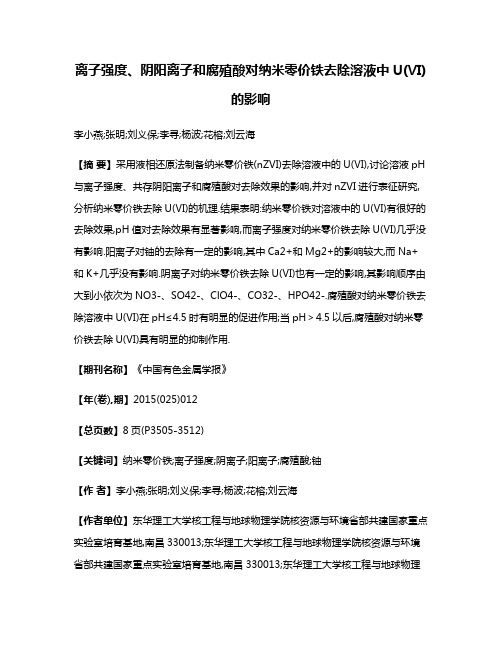
离子强度、阴阳离子和腐殖酸对纳米零价铁去除溶液中U(Ⅵ)的影响李小燕;张明;刘义保;李寻;杨波;花榕;刘云海【摘要】采用液相还原法制备纳米零价铁(nZVI)去除溶液中的U(Ⅵ),讨论溶液pH 与离子强度、共存阴阳离子和腐殖酸对去除效果的影响,并对nZVI进行表征研究,分析纳米零价铁去除U(Ⅵ)的机理.结果表明:纳米零价铁对溶液中的U(Ⅵ)有很好的去除效果,pH值对去除效果有显著影响,而离子强度对纳米零价铁去除U(Ⅵ)几乎没有影响.阳离子对铀的去除有一定的影响,其中Ca2+和Mg2+的影响较大,而Na+和K+几乎没有影响.阴离子对纳米零价铁去除U(Ⅵ)也有一定的影响,其影响顺序由大到小依次为NO3-、SO42-、ClO4-、CO32-、HPO42-.腐殖酸对纳米零价铁去除溶液中U(Ⅵ)在pH≤4.5时有明显的促进作用;当pH>4.5以后,腐殖酸对纳米零价铁去除U(Ⅵ)具有明显的抑制作用.【期刊名称】《中国有色金属学报》【年(卷),期】2015(025)012【总页数】8页(P3505-3512)【关键词】纳米零价铁;离子强度;阴离子;阳离子;腐殖酸;铀【作者】李小燕;张明;刘义保;李寻;杨波;花榕;刘云海【作者单位】东华理工大学核工程与地球物理学院核资源与环境省部共建国家重点实验室培育基地,南昌330013;东华理工大学核工程与地球物理学院核资源与环境省部共建国家重点实验室培育基地,南昌330013;东华理工大学核工程与地球物理学院核资源与环境省部共建国家重点实验室培育基地,南昌330013;东华理工大学核工程与地球物理学院核资源与环境省部共建国家重点实验室培育基地,南昌330013;东华理工大学核工程与地球物理学院核资源与环境省部共建国家重点实验室培育基地,南昌330013;东华理工大学核工程与地球物理学院核资源与环境省部共建国家重点实验室培育基地,南昌330013;东华理工大学核工程与地球物理学院核资源与环境省部共建国家重点实验室培育基地,南昌330013【正文语种】中文【中图分类】X591铀是一种具有放射性的稀有金属,也是国防事业和核电产业非常重要的战略性资源[1]。
维生素B_(12)改性纳米零价镍去除溶液中U(Ⅵ)的机理
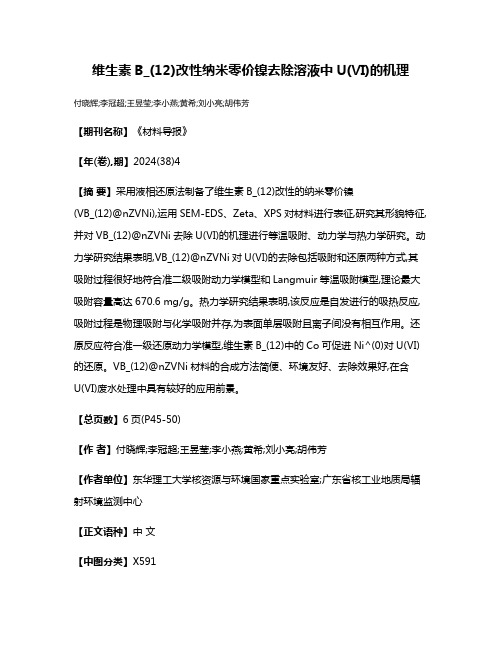
维生素B_(12)改性纳米零价镍去除溶液中U(Ⅵ)的机理付晓辉;李冠超;王昱莹;李小燕;黄希;刘小亮;胡伟芳【期刊名称】《材料导报》【年(卷),期】2024(38)4【摘要】采用液相还原法制备了维生素B_(12)改性的纳米零价镍(VB_(12)@nZVNi),运用SEM-EDS、Zeta、XPS对材料进行表征,研究其形貌特征,并对VB_(12)@nZVNi去除U(Ⅵ)的机理进行等温吸附、动力学与热力学研究。
动力学研究结果表明,VB_(12)@nZVNi对U(Ⅵ)的去除包括吸附和还原两种方式,其吸附过程很好地符合准二级吸附动力学模型和Langmuir等温吸附模型,理论最大吸附容量高达670.6 mg/g。
热力学研究结果表明,该反应是自发进行的吸热反应,吸附过程是物理吸附与化学吸附并存,为表面单层吸附且离子间没有相互作用。
还原反应符合准一级还原动力学模型,维生素B_(12)中的Co可促进Ni^(0)对U(Ⅵ)的还原。
VB_(12)@nZVNi材料的合成方法简便、环境友好、去除效果好,在含U(Ⅵ)废水处理中具有较好的应用前景。
【总页数】6页(P45-50)【作者】付晓辉;李冠超;王昱莹;李小燕;黄希;刘小亮;胡伟芳【作者单位】东华理工大学核资源与环境国家重点实验室;广东省核工业地质局辐射环境监测中心【正文语种】中文【中图分类】X591【相关文献】1.用负载纳米零价铁的改性沸石从溶液中去除U(Ⅵ)试验研究2.纳米零价镍去除溶液中U(VI)的研究3.硫化纳米零价铁去除水溶液中铀的机理4.维生素B_(12)改性纳米零价镍去除溶液中U(Ⅵ)的性能5.岩棉负载纳米零价铁去除溶液中U(Ⅵ)的性能和机理因版权原因,仅展示原文概要,查看原文内容请购买。
纳米铁的表面改性及其选择性消除24DCP的机制研究
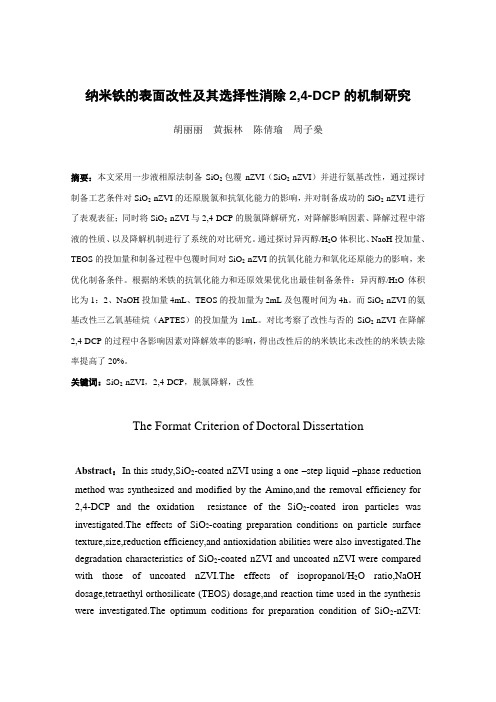
纳米铁的表面改性及其选择性消除2,4-DCP的机制研究胡丽丽黄振林陈倩瑜周子燊摘要:本文采用一步液相原法制备SiO2包覆nZVI(SiO2-nZVI)并进行氨基改性,通过探讨制备工艺条件对SiO2-nZVI的还原脱氯和抗氧化能力的影响,并对制备成功的SiO2-nZVI进行了表观表征;同时将SiO2-nZVI与2,4-DCP的脱氯降解研究,对降解影响因素、降解过程中溶液的性质、以及降解机制进行了系统的对比研究。
通过探讨异丙醇/H2O体积比、NaoH投加量、TEOS的投加量和制备过程中包覆时间对SiO2-nZVI的抗氧化能力和氧化还原能力的影响,来优化制备条件。
根据纳米铁的抗氧化能力和还原效果优化出最佳制备条件:异丙醇/H2O体积比为1:2、NaOH投加量4mL、TEOS的投加量为2mL及包覆时间为4h。
而SiO2-nZVI的氨基改性三乙氧基硅烷(APTES)的投加量为1mL。
对比考察了改性与否的SiO2-nZVI在降解2,4-DCP的过程中各影响因素对降解效率的影响,得出改性后的纳米铁比未改性的纳米铁去除率提高了20%。
关键词:SiO2-nZVI,2,4-DCP,脱氯降解,改性The Format Criterion of Doctoral DissertationAbstract:In this study,SiO2-coated nZVI using a one –step liquid –phase reduction method was synthesized and modified by the Amino,and the removal efficiency for 2,4-DCP and the oxidation resistance of the SiO2-coated iron particles was investigated.The effects of SiO2-coating preparation conditions on particle surface texture,size,reduction efficiency,and antioxidation abilities were also investigated.The degradation characteristics of SiO2-coated nZVI and uncoated nZVI were compared with those of uncoated nZVI.The effects of isopropanol/H2O ratio,NaOH dosage,tetraethyl orthosilicate (TEOS) dosage,and reaction time used in the synthesis were investigated.The optimum coditions for preparation condition of SiO2-nZVI:isopropanol/H2O ratio 1:2, NaOH dosage 0.48~0.68, tetraethyl orthosilicate (TEOS) dosage 2mL,and reaction time parison of rates of 2,4-DCP removal by nZVI and SiO2-coated nZVI during degradation process .2,4-DCP reaction coditions and changes in solution ion concentrations with recation progress were investigated.The effects of FeSO4·7H2O dosage,2.4-DCP concentration ,pH,and co-existing ions (cations Al3+,Mn2+,Cu2+ and anions Cl-,PO43-,NO3-) on the degradation activity were investigated.The results showed that the efficiency of SiO2-coated nZVI far exceeded that of uncoated nZVI for removal of 2,4-DCP from aqueous solutions.The best removal conditions were obtained when the FeSO4·7H2O dosage of the SiO2-coated nZVI was about 3.0g,the 2.4-DCP concentration was 100mg/L,and the pH was about 2.73.Keywords:SiO2-nZVI,2,4-DCP,dechlornation degradation ,modified.氯代有机物是一类污染面广、毒性较大、不易降解的化合物,因其具有高挥发性和类脂物可溶性等特点,易通过食入、吸入、经皮吸收等方式而在生物体内积累,从而产生“三致效应”[1],其中,2,4-二氯苯酚是合成农药如除草醚、2,4-二氯苯氧乙酸及其衍生物伊比磷及医药硫双二氯酚的中间体,同时还用于制造防蛀、防腐和种子消毒的某些甲基化合物等,大量的2,4-二氯苯酚在其生产及使用过程中进入环境,对环境和健康的潜在风险极大,尤其对水体和土壤造成极大严重污染,已经成为当前研究的热点问题之一。
纳米零价铁对水溶液中Cr(Ⅵ)的去除效果
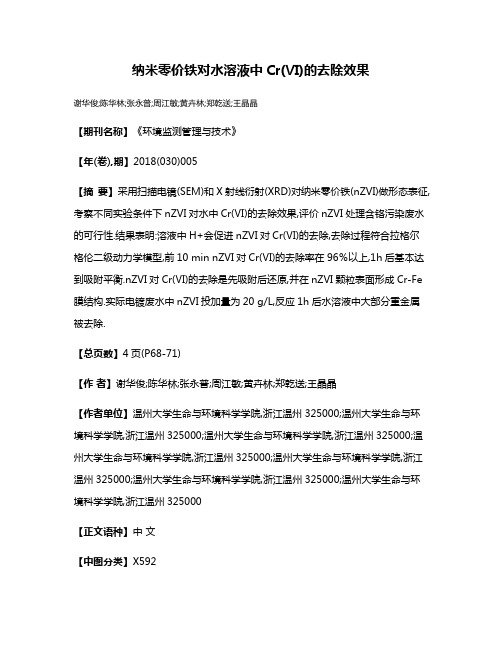
纳米零价铁对水溶液中Cr(Ⅵ)的去除效果谢华俊;陈华林;张永普;周江敏;黄卉林;郑乾送;王晶晶【期刊名称】《环境监测管理与技术》【年(卷),期】2018(030)005【摘要】采用扫描电镜(SEM)和X射线衍射(XRD)对纳米零价铁(nZVI)做形态表征,考察不同实验条件下nZVI对水中Cr(Ⅵ)的去除效果,评价nZVI处理含铬污染废水的可行性.结果表明:溶液中H+会促进nZVI对Cr(Ⅵ)的去除,去除过程符合拉格尔格伦二级动力学模型,前10 min nZVI对Cr(Ⅵ)的去除率在96%以上,1h后基本达到吸附平衡.nZVI对Cr(Ⅵ)的去除是先吸附后还原,并在nZVI颗粒表面形成Cr-Fe 膜结构.实际电镀废水中nZVI投加量为20 g/L,反应1h后水溶液中大部分重金属被去除.【总页数】4页(P68-71)【作者】谢华俊;陈华林;张永普;周江敏;黄卉林;郑乾送;王晶晶【作者单位】温州大学生命与环境科学学院,浙江温州325000;温州大学生命与环境科学学院,浙江温州325000;温州大学生命与环境科学学院,浙江温州325000;温州大学生命与环境科学学院,浙江温州325000;温州大学生命与环境科学学院,浙江温州325000;温州大学生命与环境科学学院,浙江温州325000;温州大学生命与环境科学学院,浙江温州325000【正文语种】中文【中图分类】X592【相关文献】1.改性玉米秸秆对含铜废水溶液中Cu2+的去除效果 [J], 朱灵峰;王小敏;郭毅萍;叶朝;吴洁琰2.钢渣对水溶液中U(Ⅵ)去除效果的研究 [J], 杨天梓; 张卫民3.硫化纳米零价铁去除水溶液中铀的机理 [J], 杨千语;王慧珍;李冬涵;刘清;滑熠龙4.生物炭负载纳米零价铁对水体典型污染物去除效果的研究进展 [J], 杨丹;高鹏程;黄徐;王檬;肖雪;刘智峰5.活性炭负载纳米零价铁去除水溶液中U(Ⅵ)的研究 [J], 刘大前;刘峙嵘;王长福;赖毅;黄新因版权原因,仅展示原文概要,查看原文内容请购买。
纳米零价铁基双金属复合材料降解水体污染物的研究进展
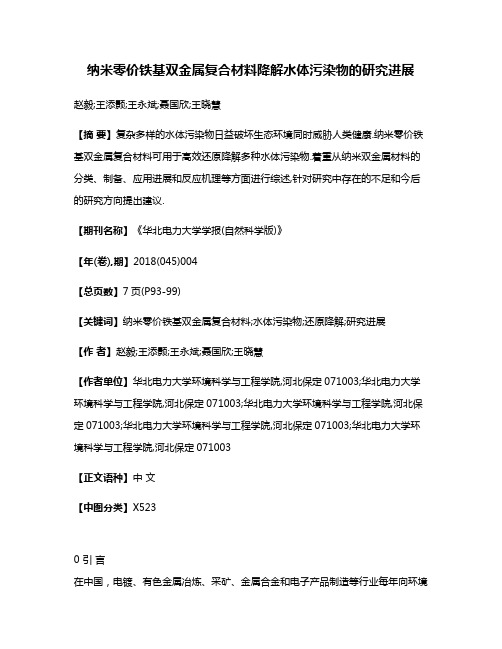
纳米零价铁基双金属复合材料降解水体污染物的研究进展赵毅;王添颢;王永斌;聂国欣;王晓慧【摘要】复杂多样的水体污染物日益破坏生态环境同时威胁人类健康.纳米零价铁基双金属复合材料可用于高效还原降解多种水体污染物.着重从纳米双金属材料的分类、制备、应用进展和反应机理等方面进行综述,针对研究中存在的不足和今后的研究方向提出建议.【期刊名称】《华北电力大学学报(自然科学版)》【年(卷),期】2018(045)004【总页数】7页(P93-99)【关键词】纳米零价铁基双金属复合材料;水体污染物;还原降解;研究进展【作者】赵毅;王添颢;王永斌;聂国欣;王晓慧【作者单位】华北电力大学环境科学与工程学院,河北保定071003;华北电力大学环境科学与工程学院,河北保定071003;华北电力大学环境科学与工程学院,河北保定071003;华北电力大学环境科学与工程学院,河北保定071003;华北电力大学环境科学与工程学院,河北保定071003【正文语种】中文【中图分类】X5230 引言在中国,电镀、有色金属冶炼、采矿、金属合金和电子产品制造等行业每年向环境水体中排放大量包含多种重金属离子的工业废水,根据中国国家统计局2013年发布的环境统计数据,其总量超过10亿立方米[1]。
水体中大部分痕量的重金属便具有剧毒性和不可降解性,易在食物链中富集而表现出生物放大效应,严重危及生态系统和人身健康[2, 3]。
此外,水体中含量超标的阴离子如硝酸根、亚硝酸根和磷酸根等将引发水体富营养化和生物多样性锐减等不可挽回的环境问题[4]。
世界卫生组织规定,饮用水中硝酸盐含量不得超过50 mg/L[5]. 而美国环境保护署在2013年更严格限定,饮用水中硝酸盐、亚硝酸盐和铅的容许极限分别为10 mg/L、1 mg/L 和15 μg/L. 除上述无机污染物,被污染水体中还包含诸多有机污染物,如氯化烃类[6]、硝基苯[7]、含氯苯酚[8]、多氯联苯(PCBs)[9]和杀虫剂[10]等。
- 1、下载文档前请自行甄别文档内容的完整性,平台不提供额外的编辑、内容补充、找答案等附加服务。
- 2、"仅部分预览"的文档,不可在线预览部分如存在完整性等问题,可反馈申请退款(可完整预览的文档不适用该条件!)。
- 3、如文档侵犯您的权益,请联系客服反馈,我们会尽快为您处理(人工客服工作时间:9:00-18:30)。
doi:10.3969/j.issn.1007-7545.2018.07.017纳米铁镍双金属去除溶液中U(VI)的性能研究刘晴晴,李小燕,秦启凤,刘宸,张梓晗,刘学,陈玉洁(东华理工大学省部共建核资源与环境国家重点实验室培育基地,南昌330013)摘要:采用同步液相法制备纳米Fe/Ni双金属来去除溶液中的U(VI),通过BET、SEM等方法对双金属材料进行表征分析,用批试验法研究n(Fe)/n(Ni)比、pH、初始铀浓度、反应时间和温度对去除U(VI)的影响。
结果表明,铁镍双金属体系去除U(VI)的最佳pH为3.5,反应平衡时间为30 min,25 ℃时的饱和吸附量为161.91 mg/g。
关键词:纳米铁镍双金属;铀;去除;吸附量中图分类号:TL941+.19 文献标志码:A 文章编号:1007-7545(2018)07-0000-00Removal of U(VI) from Aqueous Solution with Nanoscale Fe/Ni BimetalLIU Qing-qing , LI Xiao-yan, QIN Qi-feng, LIU Chen, ZHANG Zi-han, LIU Xue, CHEN Yu-jie(State Key Laboratory Breeding Base of Nuclear Resources and Environment, East China University of Technology,Nanchang 330013, China)Abstract:Nanoscale Fe/Ni bimetal was prepared by synchronous liquid phase method to remove U(VI) from aqueous solution. Nanoscale Fe/Ni bimetal was characterized by BET and SEM. Effects of n(Fe)/n(Ni), pH value, initial U(VI) concentration, adsorption time, and adsorption temperature on remove of U(VI) were investigated by batch test method. The results show that adsorption capacity is 161.91 mg/g at pH=3.5, adsorption time of 30 min, and adsorption temperature of 25 ℃.Key words:nanoscale Fe/Ni bimetal; uranium; removal; adsorption capacity铀是存在于环境中最广泛的放射性和有毒重金属之一[1]。
U(VI)可以通过多种途径释放到环境中去,如核工业、天然矿床、化肥和其它加工铀的应用[2]。
即使废水中的U(VI)浓度相当低,也会对人体造成危害。
我国规定生产设施排放废水中铀的限值为0.3 mg/L,第一取水点限值0.05 mg/L[3]。
因此,非常有必要对含铀废水进行有效的处理。
目前,常规去除含铀废水中铀离子的方法主要有化学沉淀法、离子交换、生物吸附等[4]。
其中大多数的方法都具有一些局限性,例如成本高、效率低、能耗高和产生二次污染物等[5]。
寻找更加有效的含铀废水处理技术成为研究的热点。
纳米零价铁(nZVI)具有比表面积大、反应活性高、吸附性能强等特性,通过还原、吸附、沉淀等机理去除水中多种重金属[6]。
nZVI的强还原性使其在制备、反应过程中容易发生腐蚀和氧化反应,形成铁的氢氧化物[7],阻止nZVI与目标污染物的接触,使得nZVI的电子无法传递到颗粒表面将目标污染物还原,从而大大减弱了其反应活性,降低了其修复速率。
研究发现,在纳米零价铁系引入另外一种还原电位高的金属后,在nZVI 表面形成原电池促进电子的转移,加快nZVI反应速率[8]。
此外,在一定程度上可以防止钝化层的形成[9]。
已有研究[10-11]表明,负载另一种金属后去除溶液中重金属的效率明显高于单纯的nZVI。
目前,纳米Fe/Ni双金属材料在去除溶液中U(VI)的研究还未见报道。
本研究采用同步液相还原法制备纳米Fe/Ni双金属材料去除溶液中的U(VI),通过研究材料制备中Fe、Ni比例和反应过程中溶液pH、Fe/Ni投加量、反应时间、U(VI)溶液初始浓度、反应温度等对去除溶液中U(VI)的影响,探讨了纳米Fe/Ni双金属颗粒去除U(VI)的反应机理,为其在含铀废水的实际应用中提供理论依据。
1 试验材料和方法基金项目:国家自然科学基金资助项目(11465002,11205030,41761090);江西省自然科学基金项目(20171ACB2021);核资源与环境国家重点实验室项目(NRE1608);东华理工大学研究生创新项目1.2 纳米Fe/Ni双金属材料的制备将0.05 mol/L的FeCl3·6H2O溶液和NiCl2·6H2O溶液按一定的比例混合均匀后,与0.25 mol/L的KBH4溶液按1︰1的体积比混合,经磁力搅拌器搅拌0.5 h后,用磁选法选出,将制得的Fe/Ni双金属颗粒依次用去离子水和无水乙醇洗涤多次后,在80 ℃的真空干燥箱烘干10 h备用。
1.3 吸附试验准确称取一定量的Fe/Ni双金属颗粒,加入到30 mL一定浓度的铀溶液中,用0.5 mol/L硝酸或氢氧化钠调节溶液pH,置于气浴恒温振荡器中,在25 ℃以130 r/min速率振荡一定时间后离心,取上清液用分光光度法测定剩余U(VI)浓度。
纳米Fe/Ni双金属吸附铀的平衡吸附量q(mg/g)以及去除率R分别按照下式计算:(1)(2)式中,C0和C e分别为铀的初始和平衡质量浓度(mg/L);M为吸附剂质量(g);V为溶液体积(L)。
2 结果与分析2.1 材料表征2.1.1 N2吸附—脱附用BELSORP-miniⅡ比表面积分析仪在液氮环境中完成以氮气为吸附质的吸附和脱附过程,利用BET方程计算在相对压力为0.05~0.25材料的比表面积S BET。
测试结果得到的nZVI和纳米铁镍双金属的比表面积分别为16.23 m2/g和26.10 m2/g,说明镍的添加有效增大了反应比表面积。
2.1.2 扫描电镜分析图1为铁镍双金属反应前后的SEM形貌。
由图1可见,反应前的铁镍双金属由纳米片状聚集在一起,形似“花瓣”,并且表面负载了许多纳米颗粒,分散性较好,表明镍的引入可以有效抑制纳米零价铁的团聚,增大了反应面积。
反应后的铁镍双金属材料由不规则碎片堆积而成,这可能是材料被腐蚀以及表面吸附了大量的U(VI)而形成的。
图1 纳米Fe/Ni双金属与铀反应前(a)和反应后(b)的SEM形貌Fig.1 SEM image of nanoscale Fe/Ni bimetal before adsorption (a) and after adsorption (b) for U(VI)2.1.3 能谱分析用X射线能量色散仪(EDAX)对纳米铁镍与铀反应前后的表层进行扫描后,可以知道样品各元素的组成情况及含量特征,结果见表1。
从表1可看出,新制得的材料中除了含有铁、镍元素外,还含有碳、氧元素,这可能是空气中的二氧化碳溶于水中产生的。
反应后的材料中则出现了铀元素且质量百分比占到了6.79%,这说明该材料确实对UO22+生了吸附作用。
表1 纳米Fe/Ni双金属与铀反应前后的EDS结果Table 1 EDS results of nanoscale Fe/Ni bimetal before and after adsorption for U(VI) /%元素吸附前吸附后质量百分比原子百分比质量百分比原子百分比C 35.14 58.30 5.25 13.14O 21.14 26.32 29.26 55.01 Fe 31.41 11.21 34.61 18.64 (a) (b)2.2 n (Fe)/n (Ni)对去除U(VI)的影响取0.9 mg 不同铁镍质量比的复合材料,分别投入C 0=50 mg/L 、V =30 mL 的溶液中,在T =298.15 K 及不同pH 下对U(VI)进行去除试验,结果如图2所示。
可以看出,随着镍的物质的量的增大,对U(VI)的去除率也逐渐增大。
当n (Fe)/n (Ni)为3︰1、pH 为3.5~6.5时,U(VI)的去除率都在90%以上。
随着镍的增加,去除率并没有进一步提高,镍的过量可能导致nZVI 的表面被完全覆盖,使得双金属反应活性降低。
故选择n (Fe)/n (Ni)为3︰1的双金属材料为最佳吸附材料。
34567830405060708090100R /%pHnZVI n (Fe):n (Ni)=10:1n (Fe):n (Ni)=7:1n (Fe):n (Ni)=5:1n (Fe):n (Ni)=3:1n (Fe):n (Ni)=1:1图2 n (Fe)/n (Ni)对Fe/Ni 双金属去除U(VI)的影响Fig.2 Effect of n (Fe)/n (Ni) of Fe/Ni bimetal on removal of U(VI)镍在纳米铁镍双金属去除U(VI)的主要作用是基于二者的电位差不同,还原电位高的镍促进了铁表面的电子转移,提高了零价铁的反应活性,加速了铁的腐蚀,使得还原反应加快;同时它作为加氢催化剂,将腐蚀产生的氢气吸附在双金属表面,再将分子态转化为原子态的[H],它的还原性较强。
其反应过程如下:(3)(4)(5)[H] (6) 2.3 初始pH 对去除U(VI)的影响在C 0=50 mg/L 、V =30 mL 、m =0.9 mg 、T =298.15 K 下反应60 min ,溶液初始pH 对nZVI 与铁镍双金属材料去除U(VI)的影响如图3所示。
由图3可见,铁镍双金属在pH 为3.5~6.0的范围内,吸附容量都在140 mg/g 以上,在pH 为3.5时达到了最大吸附容量156.04 mg/g ,且吸附容量明显高于nZVI 。
而纳米零价铁在pH >5.0时,吸附容量迅速下降,因为随着溶液中OH -浓度的增加,溶液中的OH -与形成[UO 2OH]+、[(UO 2)3(OH)4]2+、[(UO 2)3(OH)5]+、[(UO 2)2(OH)2]2+、[(UO 2)2OH]3+、[(UO 2)3OH]5+、[(UO 2)4OH]7+、[UO 2(OH)4]2-、[(UO 2)3(OH)7]-等络合离子[12],使得nZVI 对铀酰离子的吸附量减小;另外,水中溶解的CO 2与UO 22+结合形成了较为稳定的碳酸铀酰络合阴离子,如(UO 2(CO 3)2)2-,(UO 2(CO 3)3)4-等[13],这会造成nZVI 对铀的吸附量降低。
